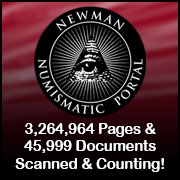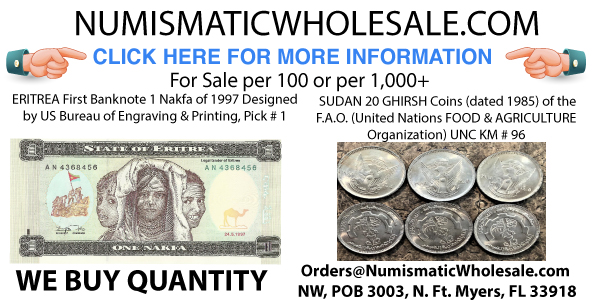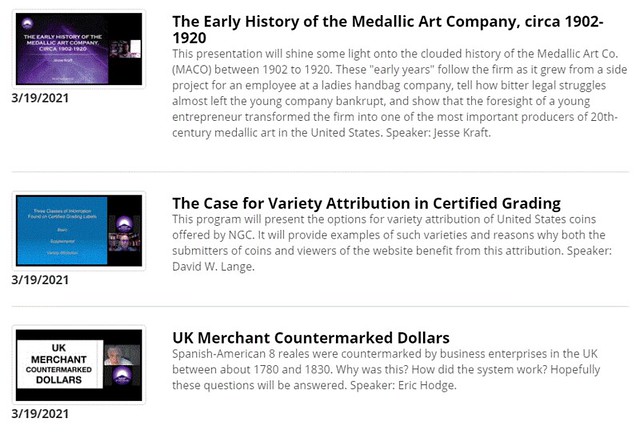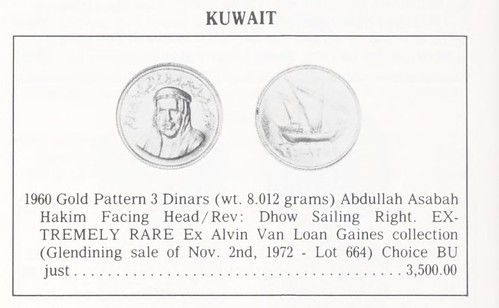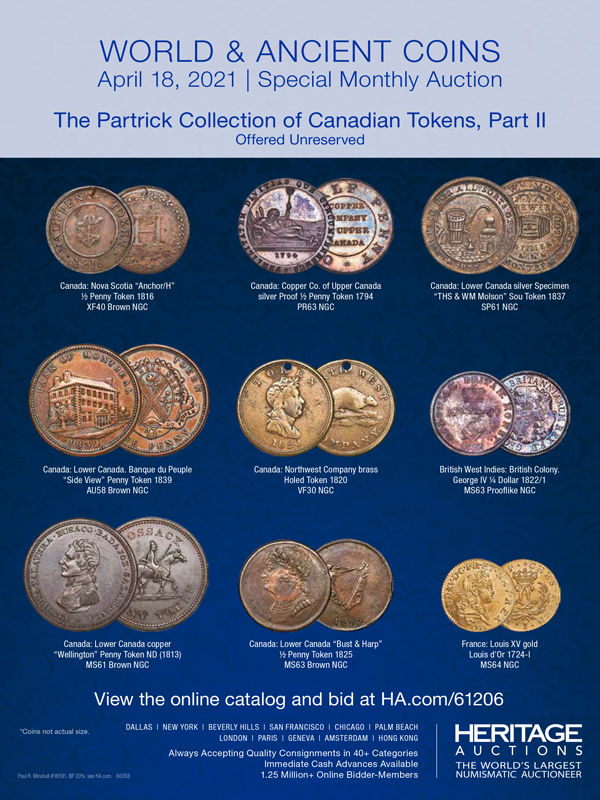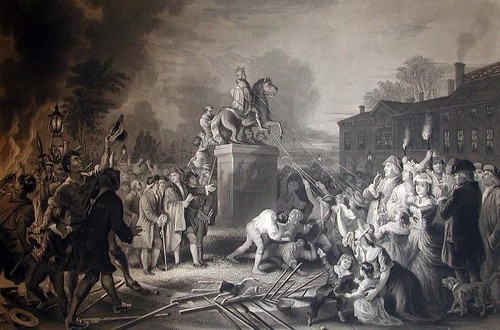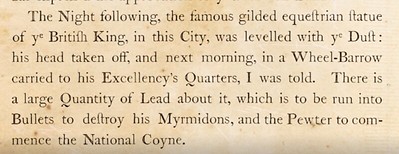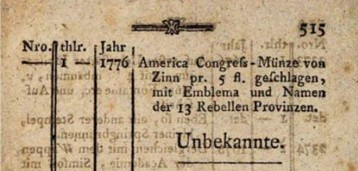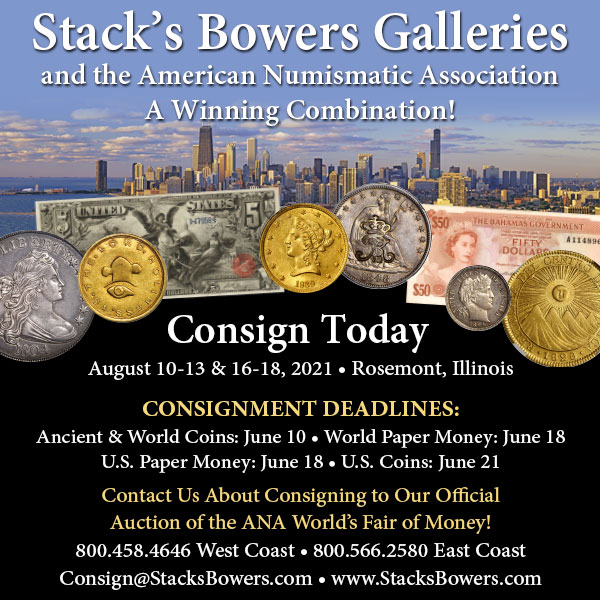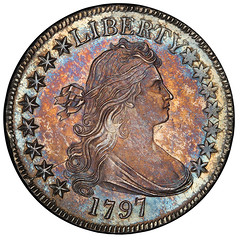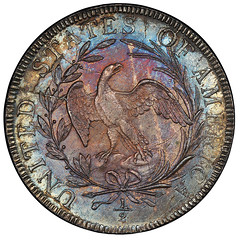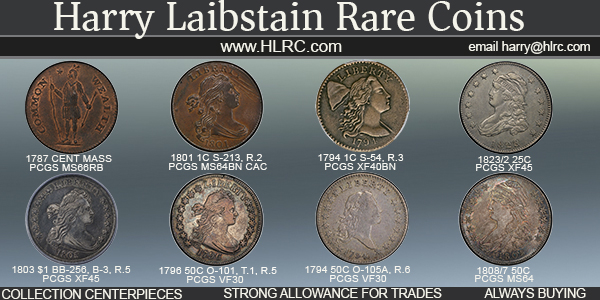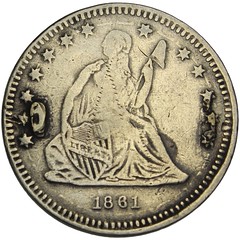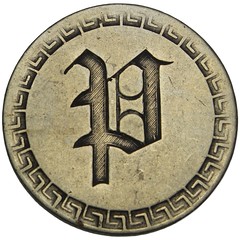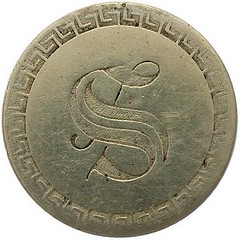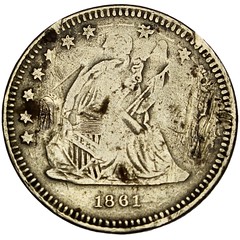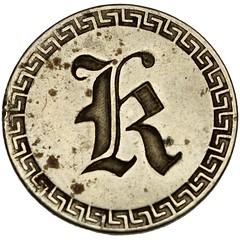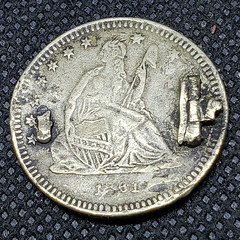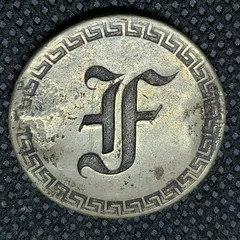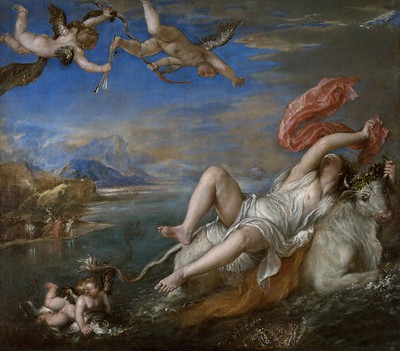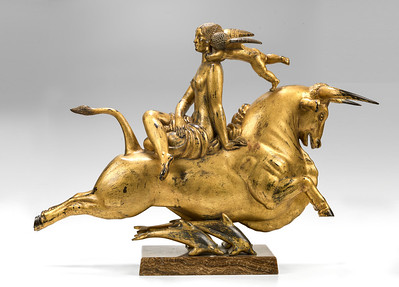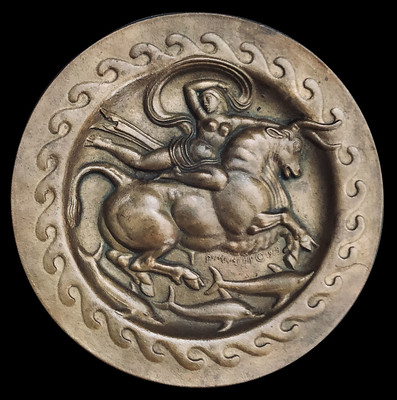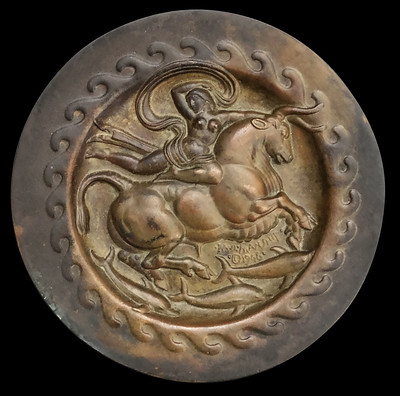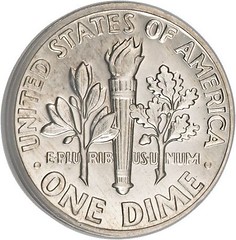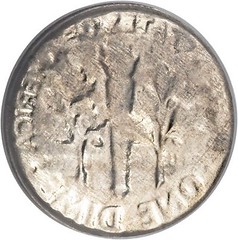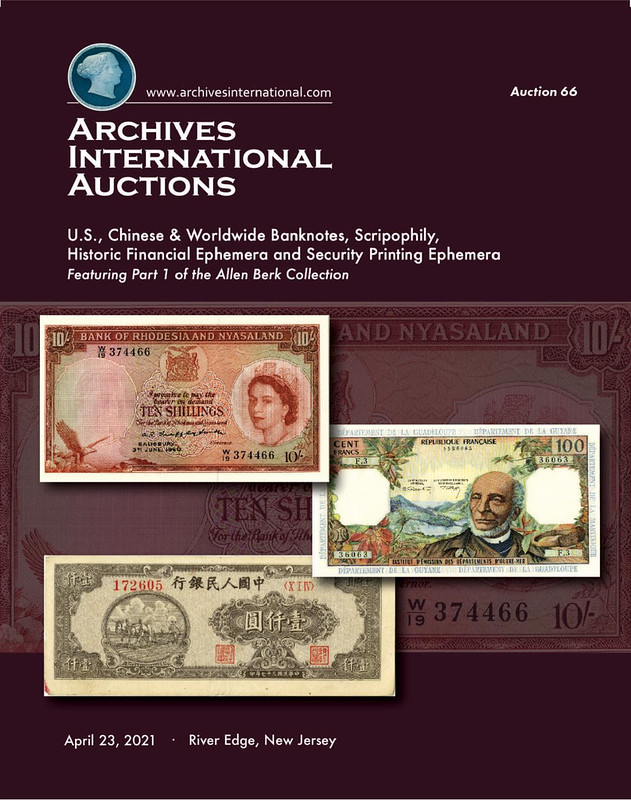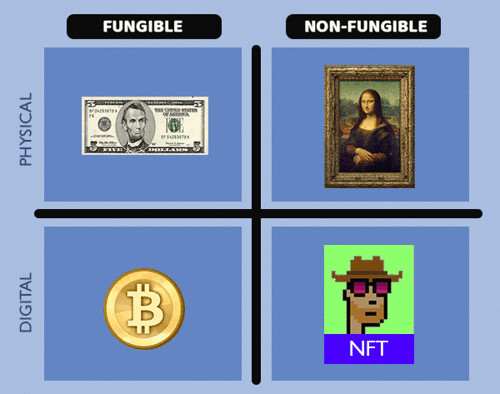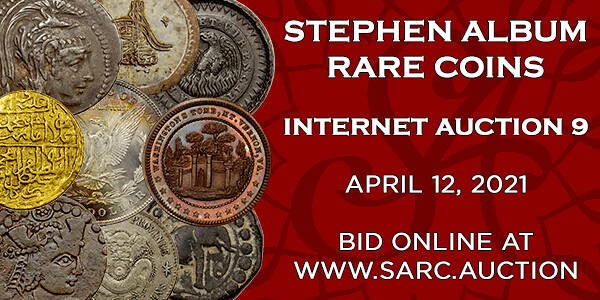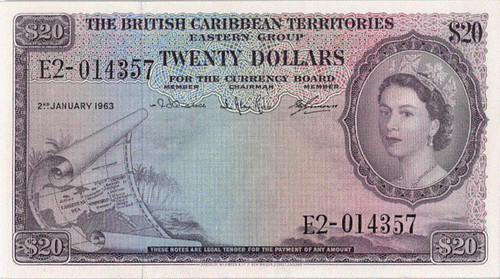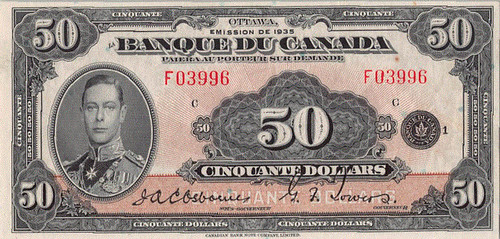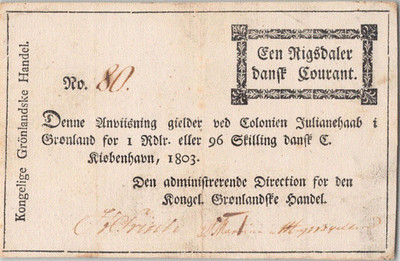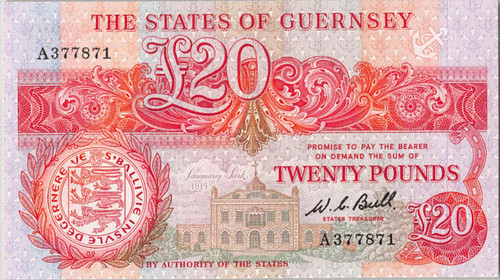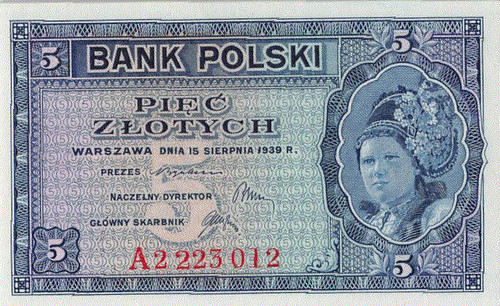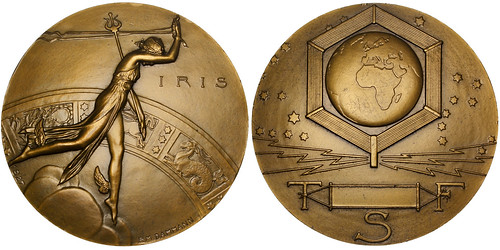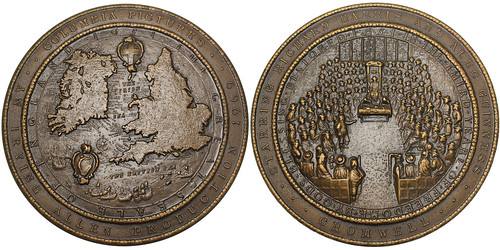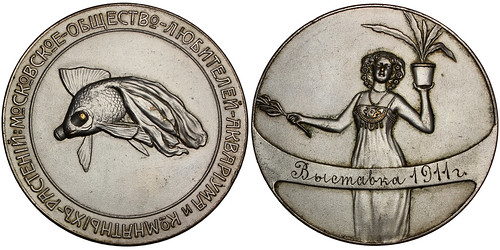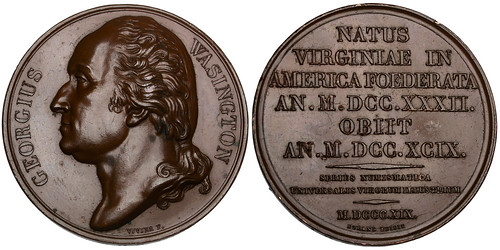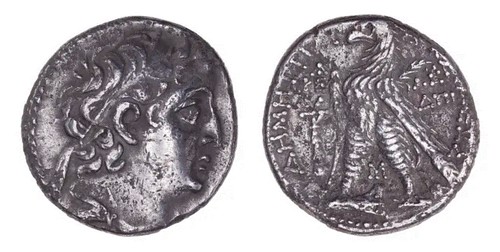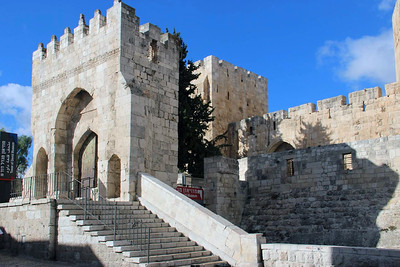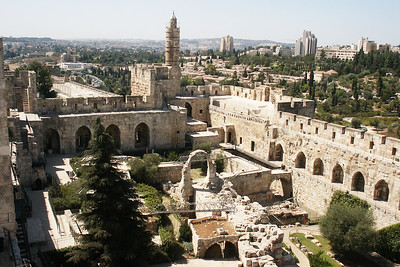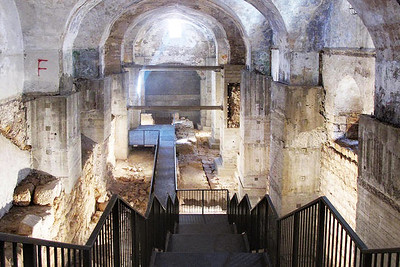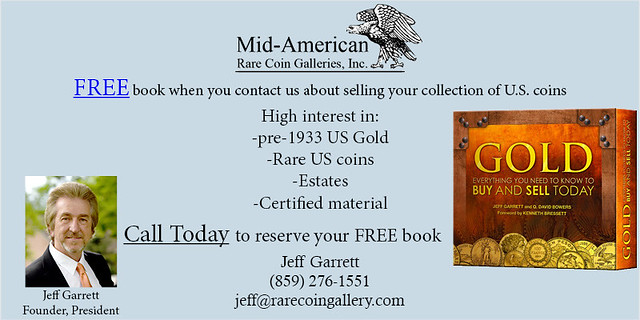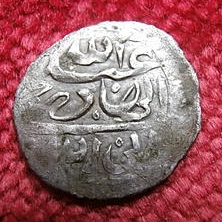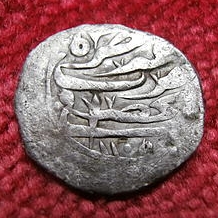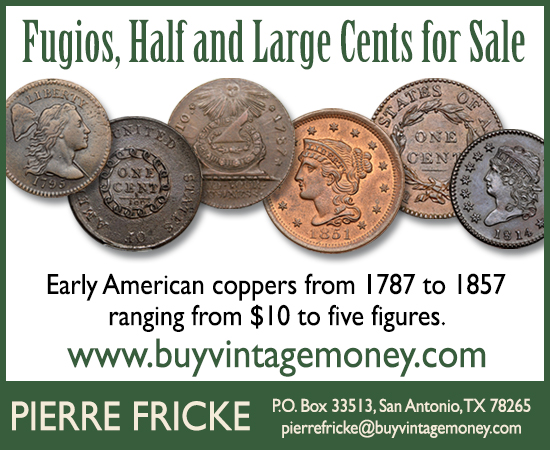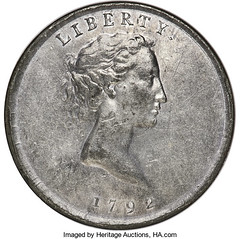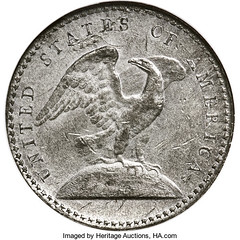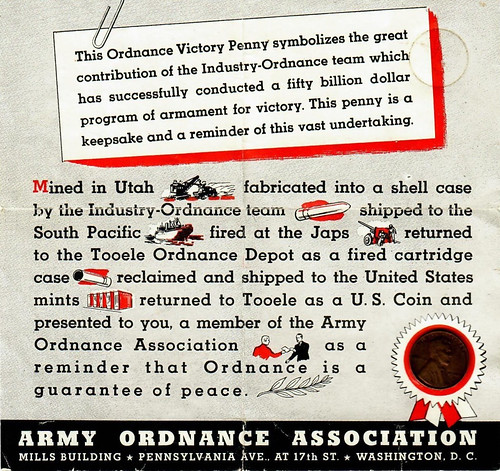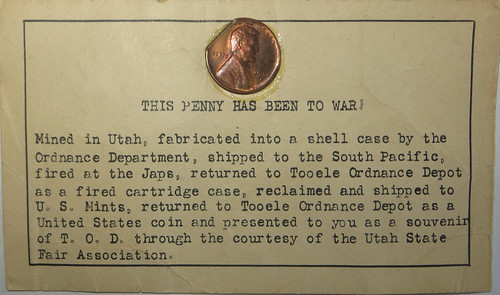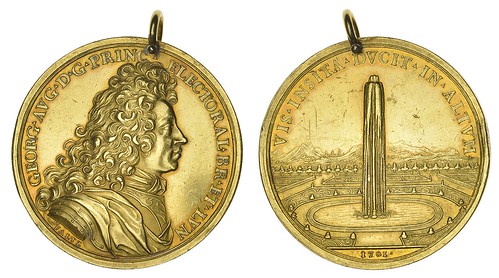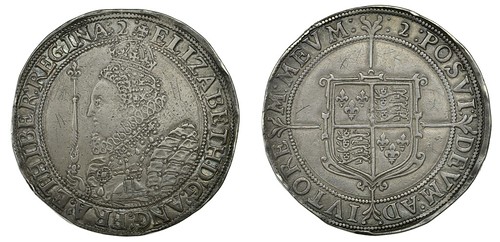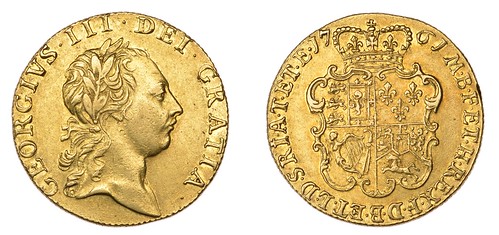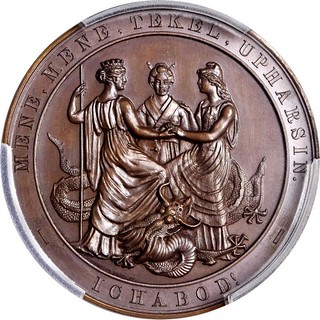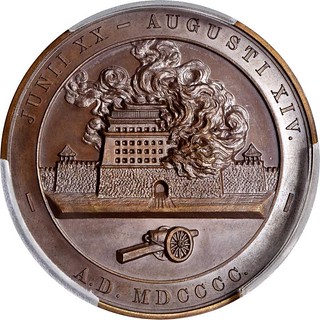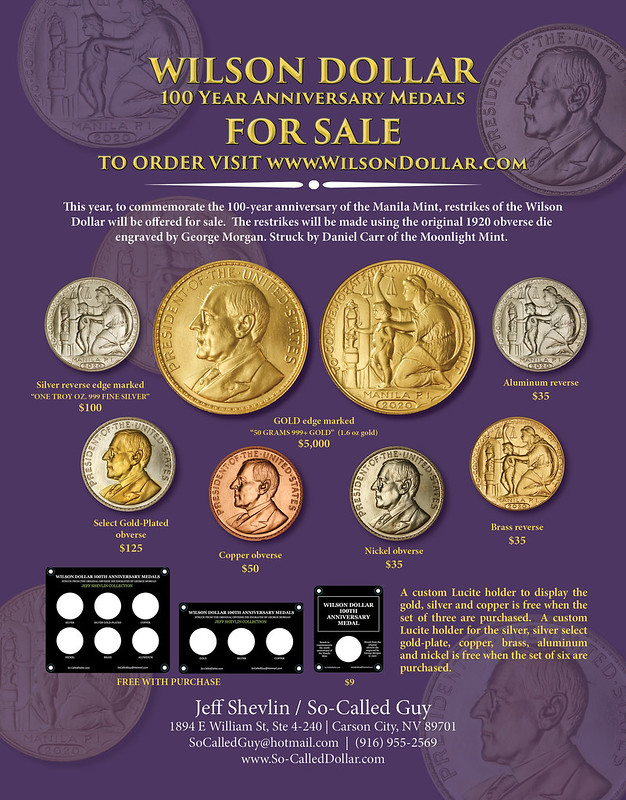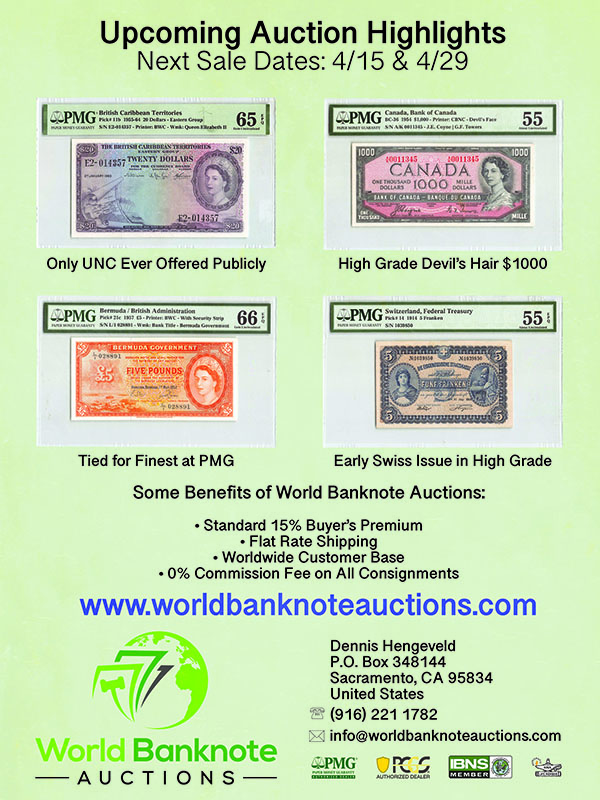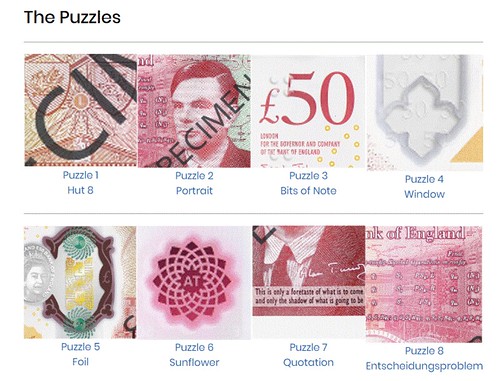
Visit our NBS Sponsors


About UsThe Numismatic Bibliomania Society is a non-profit association devoted to the study and enjoyment of numismatic literature. For more information please see our web site at coinbooks.org SubscriptionsThose wishing to become new E-Sylum subscribers (or wishing to Unsubscribe) can go to the following web page link MembershipThere is a membership application available on the web site Membership Application To join, print the application and return it with your check to the address printed on the application. Print/Digital membership is $40 to addresses in the U.S., and $60 elsewhere. A digital-only membership is available for $25. For those without web access, write to: Charles Heck, Treasurer AsylumFor Asylum mailing address changes and other membership questions, contact Chuck at this email address: treasurer@coinbooks.org SubmissionsTo submit items for publication in The E-Sylum, write to the Editor at this address: whomren@gmail.com BUY THE BOOK BEFORE THE COINSale Calendar |
- WAYNE'S WORDS: THE E-SYLUM APRIL 4, 2021
- NEW BOOK EXAMINES 1913 LIBERTY NICKELS
- SECOND NNP SYMPOSIUM VIDEOS AVAILABLE
- STEINBERG'S FIXED PRICE LISTS ON NNP
- DAVID R. CERVIN: FIRST DATED CHRISTIAN COINAGE
- NO STATUE WAS HARMED TO MAKE CONTINENTALS
- NOTES FROM E-SYLUM READERS: APRIL 4, 2021
- LOVE TOKENS ON COUNTERFEIT SEATED QUARTERS
- MANSHIP'S DIANA AND FLIGHT OF EUROPA
- VOCABULARY TERM: DEBONDED, DEBONDING
- JOSEPH NAPOLEON TRICOT LEVICK (1828-1908)
- 2022 NYINC EDUCATIONAL PROGRAMS
- MORE ON NON-FUNGIBLE TOKENS
- WORLD BANKNOTE AUCTIONS SALE 7 HIGHLIGHTS
- NUMISMAGRAM SELECTIONS: APRIL 2021
- SECOND TEMPLE PERIOD SHEKEL REDISCOVERED
- ROMAN SILVER COIN HOARD FOUND IN BULGARIA
- PIRATE YEMENI COINS IN COLONIAL AMERICA
- 1792 EAGLE-ON-GLOBE QUARTER PATTERN
- ORDNANCE VICTORY PENNIES
- BRITANNIA'S EVOLUTION
- GERMAN GEORGE II MEDAL OFFERED
- SIEGE OF PEKING BOXER REBELLION MEDAL
- GEORGE FLOYD'S COUNTERFEIT $20 BILL
- PROTESTERS SPRAY DYE ON BANK OF ENGLAND
- LOOSE CHANGE: APRIL 4, 2021
- RIVERBOAT DISASTER THREATENED CHEROKEE PAYMENT
Click here to read the thin version on the web
Click here to subscribe
Click here to access the complete archive
To comment or submit articles, reply to whomren@gmail.com
Content presented in The E-Sylum is not necessarily researched or independently fact-checked, and views expressed do not necessarily represent those of the Numismatic Bibliomania Society.
WAYNE'S WORDS: THE E-SYLUM APRIL 4, 2021
 New subscribers this week include:
Gail Gabrysh, courtesy Steve Costner;
Mike Geidel, and
Lyn Linker.
Welcome aboard! We now have 6,641 subscribers.
New subscribers this week include:
Gail Gabrysh, courtesy Steve Costner;
Mike Geidel, and
Lyn Linker.
Welcome aboard! We now have 6,641 subscribers.
Thank you for reading The E-Sylum. If you enjoy it, please send me the email addresses of friends you think may enjoy it as well and I'll send them a subscription. Contact me at whomren@gmail.com anytime regarding your subscription, or questions, comments or suggestions about our content.
This week we open with one new book, multiple updates from the Newman Numismatic Portal, Notes From E-Sylum readers, and more.
Other topics this week include love tokens on counterfeit quarters, medal designer Paul Manship, J.N.T. Levick, non-fungible tokens, World Banknote Auctions highlights, coin finds, the 1792 Eagle-on-Globe pattern, ordnance victory pennies, a Boxer Rebellion medal, and George Floyd's counterfeit $20 bill.
To learn more about 1913 Liberty Head nickels, Steinberg's Fixed Price Lists, the first Christian dated coinage, Continental Dollar origins, Libertas Americana medals, die varieties, Columbia farthings, the Jules Fonrobert sale, the Diana Ashtray, debonding, the New York International, Poland Government-in-Exile notes, Britannia, George II, and the Turing Challenge, read on. Have a great week, everyone!
Wayne Homren
Editor, The E-Sylum
NEW BOOK EXAMINES 1913 LIBERTY NICKELS
Coin World reported this week on an upcoming book by John Dannreuther on U.S. Proof nickel alloy coinage. Here's a short excerpt; see the complete article online. -Editor
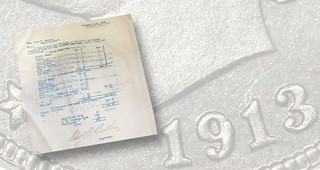 Although the three 1913 Liberty Head 5-cent coins in private hands are certified as Proofs by Professional Coin Grading Service, new soon-to-be-published research by professional numismatist John Dannreuther indicates all five clandestinely made 1913 coins were struck with circulation quality dies on unpolished planchets.
Although the three 1913 Liberty Head 5-cent coins in private hands are certified as Proofs by Professional Coin Grading Service, new soon-to-be-published research by professional numismatist John Dannreuther indicates all five clandestinely made 1913 coins were struck with circulation quality dies on unpolished planchets.
The new findings also suggest that the U.S. Mint had full intentions to strike 1913 Liberty Head 5-cent coins for general circulation.
Dannreuther is putting the finishing touches on his manuscript for a new reference on United States Proof nickel alloy coinage that will include new revelations regarding the 1913 Liberty Head 5-cent coins.
Helping to fuel the findings is a copy of an official letter from the U.S. Mint archives, addressed Dec. 31, 1913, from Chief Engraver Charles E. Barber to Philadelphia Mint Superintendent John H. Landis seeking permission to destroy used Proof dies and unused completed dies from calendar year 1913.
Dannreuther secured the documentation during a 2015 visit to the Philadelphia Mint accompanied by Whitman Publishing LLC Publisher Dennis Tucker, Littleton Coin Company President David Sundman and numismatic author and professional numismatist Q. David Bowers.
To read the complete article, see:
Dannreuther book to include new details on 1913 5¢
(https://www.coinworld.com/news/us-coins/book-to-include-new-details-on-1913-5-cent)
SECOND NNP SYMPOSIUM VIDEOS AVAILABLE
The second NNP Symposium is history, and was another great success. Congratulations to everyone involved, from the organizers and speakers to the participants who attended. I was pleased to have the opportunity to speak in the panel session on The Early Days of Online Numismatics.
Here's the post-event announcement; the videos are available now and forever on the Newman Portal. Share links to your favorite talks with your friends, or take a break and watch some of the talks you missed at the time. We'll all look forward to the next event. -Editor
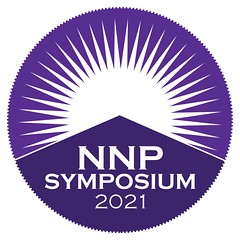 Videos from the recently concluded NNP Symposium (March 19-21) are now posted on Newman Portal. Produced by Lianna Spurrier of Numismatic Marketing, this event featured a total of 37 speakers presenting on a wide variety of numismatic topics, including United States, ancient, and world numismatics.
Videos from the recently concluded NNP Symposium (March 19-21) are now posted on Newman Portal. Produced by Lianna Spurrier of Numismatic Marketing, this event featured a total of 37 speakers presenting on a wide variety of numismatic topics, including United States, ancient, and world numismatics.
Among the presenters was John Brush, who provided a overview of the formation and evolution of the D. L. Hansen collection. This session included a lively question & answer exchange with the audience. Ken Bressett discussed his storied numismatic career, most notably covering the development of the Guide Book over the years. Shanna Schmidt delivered an overview of the ancient coin auction marketplace, noting a number of differences for those us more familiar with the largest U.S. auction firms. These are a just a few of the highlights, with the full list available on Newman Portal.
Link to NNP Symposium videos, March 19-21:
https://nnp.wustl.edu/library/multimediadetail/539070?Year=2021&take=50
STEINBERG'S FIXED PRICE LISTS ON NNP
The latest additions to the Newman Numismatic Portal are Steinberg's Fixed Price Lists. Project Coordinator Len Augsburger provided the following report. Thanks. -Editor
Steinberg's Fixed Price Lists on Newman Portal
The late William Fox Steinberg (1913-1995), dealer in world gold coins, founded Steinberg's in 1950. The firm is currently headed by Robert L. Steinberg (William's son) and Michael D. Sottini (Robert's step-son). Steinberg's has generously made available the historic fixed price lists of this firm, and these have been recently scanned by Newman Portal. The currently posted group covers 1974-2020 and we anticipate adding additional issues going forward. Although not completely illustrated, this material will enable the discovery of "needles in haystacks," for example the presentation here of a Kuwait 1960 gold pattern 3 dinars, from the Winter 1978 / Spring 1979 fixed price list.
Link to Steinberg's Fixed Price Lists on Newman Portal
https://nnp.wustl.edu/library/publisherdetail/541978
Link to search Steinberg's Fixed Price Lists:
https://archive.org/details/newmannumismatic?and%5b%5d=creator%3A%22steinberg%27s%22
THE BOOK BAZARRE
DAVID R. CERVIN: FIRST DATED CHRISTIAN COINAGE
These are selections from the David Lisot Video Library that feature news and personalities from the world of coin collecting. David has been attending coin conventions since 1972 and began videotaping in 1985. The Newman Numismatic Portal now lists all David's videos on their website at:
https://nnp.wustl.edu/library/multimediadetail/522852
David Lisot writes:
"In the spirit of Easter here is numismatist David Cervin talking about the first dated Christian coinage!"
First Three Christian A.D. Dated Numismatic Items
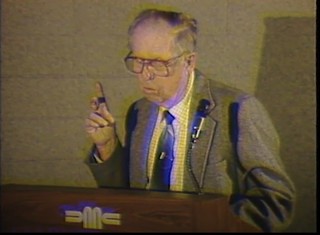 Multi-Media Summary: David Lisot Video Library (1992)
Multi-Media Summary: David Lisot Video Library (1992)
It was over one thousand years after the death of Jesus Christ before coins were dated with the Anno Domini numbering system. Hear fascinating stories of the first Christian dated coins as told by veteran collector David R. Cervin. You"ll hear tales of kings, Crusades, and powerful Bishops in this extraordinary video as well as see close-up examples of the coins.
Speaker: David R. Cervin.
An excerpt of the video is available for viewing on NNP at:
https://nnp.wustl.edu/library/book/578852
NO STATUE WAS HARMED TO MAKE CONTINENTALS
April 1st is behind us. We were more low-key about April Fool's Day this year, with just one item courtesy the Newman Numismatic Portal. That new Continental dollar evidence? Sorry, April Fool! There's no evidence that the coins were struck from metal from the statue of King George III destroyed by a mob of New York City patriots in 1776. -Editor
Bill Eckberg writes:
"The image of the "collector" who bought the arm and hand was my first clue. The ending gave it away.
"Lianna's a really good straight-faced satirist."
Relic pieces such as the 1792 "Liberte Francoise" medal and VIGO coinage of course exist, as do piece parts of the destroyed 1770 George III equestrian statue. Collector "Rex Robertson" does not exist, and no energy dispersive spectroscopy tests have been done comparing the statue's metal to the Continental Dollar coins. The "Solomon Drowne" letter was made up, too, but Sarah Sophia Banks' flyer about "These American Medals" is real. -Editor
Julia Casey writes:
"Your April Fools joke was a masterpiece! I thought it looked a little strange because you couldn't click through anywhere to see the source of the Drowne letter - but it was quite convincing! I thought the video would be an overview of all the past writings on the history of the Continental Dollar and didn't realize that it was about that topic so I didn't watch it until after I was somewhat fooled! But then I knew. Well played by all of you!"
On a related note Bob Leonard writes:
"The appearance of a Continental dollar in a collection formed in Germany in the 1780s is further evidence, if any were needed, that the 1776-dated Continental dollar was made in Europe in the 1780s, if not actually in Germany; no Western Hemisphere coins after 1773 were included. As discovered by Eric P. Newman and Maureen Levine, the earliest illustration of a Continental dollar is in Germany in 1783 (The Numismatist July 2014, pp. 38-41).
"I can't agree with Ralf Böpple's speculation that it was "possible" for a Continental dollar to arrive from the United States in 1776, when they were already to be seen in Germany in 1783, two years prior to the auction.
"In my opinion the Continental dollar is a speculation by a private mint in 1783 in the hope of obtaining a contract to strike coins for the United States, now that peace was finally at hand. The 1776 date was simply copied from Continental currency. The patterns were struck in pewter since it was anticipated that many would need to be distributed to members of Congress. If "E.G." can be identified we should be able to confirm this."
Regarding the word "Unbekannt" below the Continental Dollar entry, Ralf Böpple wrote:
"The only non-European non-Colonial coin is our Continental dollar, listed last in the "miscellaneous" section, right above the very last two entries, which are unknown items ("Unbekannt")."
Herman Blanton agrees. He writes:
"In the 1785 catalog the mention of "unbekannte" does not apply to the subject item. Unbekannte is the header for the items following which had unknown attribution. The 1776 "dollar" is listed under miscellaneous."
Regarding Martin Purdy's translation of "geschlagen", Alan Luedeking writes:
"geschlagen" means struck. (As opposed to cast, I presume.)"
Thomas Lovelace writes:
"I am thinking this might be a group lot - 1 minted in pewter and 5 struck in silver.
"Zinn - pewter
pr. - pragen - minted
5
fl. - actually sl. - silber - silver
gefchlagen - geschlagen - struck"
Craig Sholley submitted these thoughts on the longevity and staying power of the Continental Dollar in the U.S. numismatic world. Thanks. -Editor
The Origin of the Continental Dollar: Historically Curious and Functionally Irrelevant
Craig Sholley
I found the musings on the Continental Dollar in the past couple issues of The E-Sylum quite interesting, especially Julia Casey's discovery of a listing in a German catalog and the reader responses. However, it suddenly dawned on me that the whole controversy over their origin is, aside from just knowing, actually quite irrelevant.
Auction records and dealer listings show that these pieces have been avidly collected in the U.S. for over 160 years. Furthermore, as the Sarah Sophia Banks collection and German catalogs clearly show, they were collected as soon as they appeared.
As to more modern references, the Continental Dollars have been listed in the "Red Book" for as long as I can recall. The grading services certify them and list them in the "registry sets." None of that is going to change even if someone finds irrefutable proof they were made in Europe (for the record, that's what I believe, which is probably even more irrelevant than the evidence either way).
A casual review of the "Red Book" and the grading services' web sites shows why. All of those sources list numerous non-U.S. coins as part of the U.S. series. For example, in the Post- Colonial section of the Red Book, we find a number of English "Conder" tokens including the so- called "Kentucky" token (which was definitely not struck in Kentucky or anywhere else in the U.S.), the "Franklin Press" token, and the Talbot, Alum, and Lee token. I seriously doubt that anyone reading an edge inscription such as "Payable At Liverpool" thinks this means Liverpool, PA.
Then we have numerous Washington pieces having no denomination and known to have been struck in England, most likely as commemorative tokens. While some may have been used as coins, most were simply keepsakes.
I could go on, but I think everyone gets the point by now - there are numerous non-U.S. medallions and tokens collected as part of the U.S. coin series simply because they have U.S. themed devices. The Continental Dollar is no different and should be treated no differently.
For those who may feel the Continental Dollar should be "de-listed," that is a practical impossibility at this point. There is simply too much precedence to do so. Further, if this piece is to be "de-listed" because it is not of U.S. origin, then all non-U.S. pieces need to be de-listed. To do otherwise would be manifestly unfair and prejudicial against this one piece and those who choose to collect them.
That is obviously not going to happen. Enjoy the historical discussion and be "pro" or "con" as you choose. But please realize it is very unlikely to have any practical effect on the collectability of these pieces. That die was cast over two centuries ago.
The 1913 Liberty Nickel is a made-up coin, but that doesn't keep it from being an interesting multi-million dollar rarity, and I'm looking forward to John Dannreuther's new book. The Continental coins/medals/whatevers will continue to fascinate, and the discussions and investigations over their origins only make them more fascinating. Maybe I'm hanging in the wrong circles, but I haven't heard any calls for delisting and wouldn't expect that to happen.
Thanks. everyone! Great discussion. -Editor
To read the earlier E-Sylum articles, see:
KING GEORGE III STATUE PART FOUND
(https://www.coinbooks.org/v22/esylum_v22n45a28.html)
NEW CONTINENTAL DOLLAR EVIDENCE EMERGES
(https://www.coinbooks.org/v24/esylum_v24n13a07.html)
MORE ON THE 1785 CONTINENTAL DOLLAR SALE
(https://www.coinbooks.org/v24/esylum_v24n13a08.html)
NOTES FROM E-SYLUM READERS: APRIL 4, 2021
The Harry Lelande Auction CatalogDave Hirt writes:
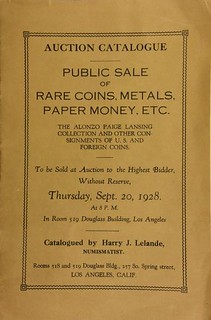 "Reading through The E-Sylum last week I came to John Lupia's bio of Harry Lelande. Thank you John!! I never knew anything about him before, although I have owned a copy of his only auction sale catalog for years, but in all that time I had never read about Lelande himself. The auction catalog I own is hand priced. As such, I believe it is very rare. The ANS copy is not listed as being priced."
"Reading through The E-Sylum last week I came to John Lupia's bio of Harry Lelande. Thank you John!! I never knew anything about him before, although I have owned a copy of his only auction sale catalog for years, but in all that time I had never read about Lelande himself. The auction catalog I own is hand priced. As such, I believe it is very rare. The ANS copy is not listed as being priced."
Thanks. I added an image of the cover of the American Numismatic Society's copy of Lelande's 1928 sale from the Newman Numismatic Portal. It's a nice sale of varied material including colonials, a Chain cent, medals, a Lesher dollar, Confederate and Southern States Currency, Encased Postage, and numismatic literature, including an impressive run of The Numismatist. -Editor
To read the catalog on NNP, see:
Public sale of rare coins, metals, paper money, etc., the Alonzo Paige Lansing collection ... of U.S. and foreign coins ... [09/20/1928]
(https://nnp.wustl.edu/library/auctionlots?AucCoId=511144&AuctionId=520399)
To read the earlier E-Sylum article, see:
HARRY JASON LELANDE (1871-1965)
(https://www.coinbooks.org/v24/esylum_v24n13a14.html)
Nathan Markowitz writes:
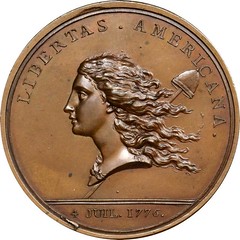 "I wish to embark on an impossible mission: I hope to trace the provenance of extant Libertas Americana medals in both Bronze and Silver to the fullest extent possible. Given their amazing iconography and historic involvement by one named B. Franklin, perhaps I can connect some dots. I am asking anyone who owns or has previously owned an example to forward me any known information on provenance prior to and since their ownership. You are free to include or exclude any price information but exact dates of acquisition and sale and any auction appearances with specific lot numbers would be most helpful.
"I wish to embark on an impossible mission: I hope to trace the provenance of extant Libertas Americana medals in both Bronze and Silver to the fullest extent possible. Given their amazing iconography and historic involvement by one named B. Franklin, perhaps I can connect some dots. I am asking anyone who owns or has previously owned an example to forward me any known information on provenance prior to and since their ownership. You are free to include or exclude any price information but exact dates of acquisition and sale and any auction appearances with specific lot numbers would be most helpful.
"Please send to me at : cascades1787@yahoo.com and include as follows:
- Libertas (bronze/silver);
- grade apparent and/or TPG grade;
- date and place acquired/sold and
- if willing, any price information.
I will keep the current owner's name and any previous owners' names confidential as you indicate. Many thanks."
Great project! Please help if you can. -Editor
Bill Eckberg writes:
"What Constitutes a Die Variety?
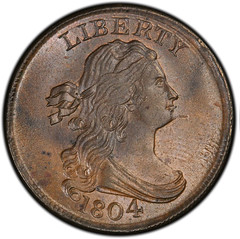 "I have talked to guys who say a die is a piece of metal, and if somebody recuts something or changes something it's the same die. Others think that even the tiniest change, like the strength of a berry stem makes for a new variety.
"I have talked to guys who say a die is a piece of metal, and if somebody recuts something or changes something it's the same die. Others think that even the tiniest change, like the strength of a berry stem makes for a new variety.
"Personally, I think any alteration has to be significant and not accidental. In the half cent world, the 1795 no-pole obverse is just a reground with-pole obverse that was used earlier. Similarly, the Spiked Chin obverse was apparently the result of some kind of damage. I consider both of those to be die states after their alteration, whether intentional or accidental."
Bill's short question could prompt some lengthy answers. Dick Johnson's Encyclopedia doesn't have a lot to say about varieties. I would just note that the discovery, naming and categorization of die varieties is driven by collectors of coins struck by the dies. Collectors notice and care about differences among the coins they collect. Many differences stem from the dies, and the reasons for the differences are many - dies wear over time, and they can be lightly or heavily retouched by engravers, they can break and either continue to be used or be replaced with entirely new dies. Dies are closely held by the mints and few end up in museum or collector hands where they can be examined. Typically the only evidence of a die's existence or state comes indirectly from the coins struck from the die, which in turn can experience further wear and deterioration of their own before coming to rest in a collection. Some varieties are boldly visible. Others are much more subtle. So where does one draw the line? Individual collectors can make their own decisions about what to collect. But what is the broad consensus about what constitutes a die variety? Where have the good/better/best definitions been published?
Saul Teichman writes:
"It is questionable to me whether or not the recently sold 1797 Lelan Rogers-Pogue half dollar is ex Brand.
"Brand owned the following 9 examples of which only one was described as Unc, the example that appeared in the April 1906 St Louis Stamp & Coin sale of the George W. Rice collection as highlighted below."
Saul has been studying the digitized Virgil Brand ledgers at the American Numismatic Society library via the Newman Numismatic Portal. -Editor
Saul adds:
"The Rice coin is imaged in the plated copy of that sale on the Newman portal with the description at the following link - https://archive.org/details/largevaluablecol00stlo/page/10/mode/2up and the coins image plated at this link - https://archive.org/details/largevaluablecol00stlo/page/114/mode/2up .
"To me the plate matches the Oliver Jung (ANR 7/04 PCGS63 sale) coin more than the Rogers-Pogue coin.
"I am curious to know what other people think."
To read the earlier E-Sylum article, see:
RECORD PRICE FOR 1797 HALF DOLLAR
(https://www.coinbooks.org/v24/esylum_v24n13a21.html)
Martin Purdy responded to this segment of the article from Franky Leeuwerck. -Editor
"The name of printer was too small, less than 2cm, about two grains of rice long. The characters, less than 1.5 mm wide, were too small for my camera to be recognized. If I could only provide a larger image. Now, that thought turned out to be a step in the right direction.
"The Google Translate software tried to recognize the words that were captured by the camera. It was necessary to find the right distance between the camera and the computer screen by holding the phone closer to and further from the screen. Then the answer appeared on the phone : Dai Nippon Printing Co., Ltd. Got it !"
Martin writes:
"That's pretty impressive, given that those aren't standard "print" characters - I was expecting total disaster as I read this item, as it would be like expecting an OCR program to cope with German Fraktur or Old English type. "
To read the earlier E-Sylum article, see:
RESEARCH USING IMAGING AND GOOGLE TRANSLATE
(https://www.coinbooks.org/v24/esylum_v24n13a18.html)
Chris Neuzil writes:
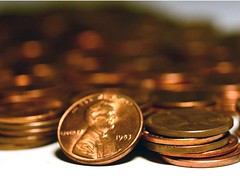 "I continue to be amazed how flummoxed people get when I try to make change from a transaction come out nicely. Case in point: $18.78 purchase. Hand over $20 bill and 3 cents. Long pause staring at money. Starts to hand back cents. Explanation. "Wow. You're really good at math!" With the Fed talking about digital US currency my remarkable skill may be useless soon."
"I continue to be amazed how flummoxed people get when I try to make change from a transaction come out nicely. Case in point: $18.78 purchase. Hand over $20 bill and 3 cents. Long pause staring at money. Starts to hand back cents. Explanation. "Wow. You're really good at math!" With the Fed talking about digital US currency my remarkable skill may be useless soon."
Considering that no one seems to be able to read an analog clock dial anymore, I'm not surprised. The same generational effect was likely present after the widespread adoption of mechanical clocks. "Kids these days, can't even read a simple sundial..."
I've also flummoxed many a young clerk while trying to simplify change-making. Blank stares. Long pauses. "OK, nevermind - take the debit card." -Editor
Jeff Rock writes:
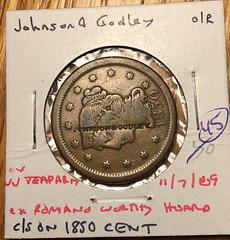 "On the Romano Hoard - Worthy Coin Co. had a VERY active bid board, and they routinely put up large lots of things. The famous colonial "Midnight Sale" Connecticut coppers came from that source - Mike Ringo literally purchased them at the shop, a few blocks from the convention hotel, and we had an auction of them a few hours later (shades of the Pennypacker sale talked about in the March 14th issue as well!). The "hoard" mentioned on the holder was likely a similar large lot, probably of counterstamps. The holder itself is in the hand of the late Steve Tannenbaum, and the coin was likely part of the Rossa and Tannenbaum inventory given that they were still in business together when the Worthy Coin Co. ceased business."
"On the Romano Hoard - Worthy Coin Co. had a VERY active bid board, and they routinely put up large lots of things. The famous colonial "Midnight Sale" Connecticut coppers came from that source - Mike Ringo literally purchased them at the shop, a few blocks from the convention hotel, and we had an auction of them a few hours later (shades of the Pennypacker sale talked about in the March 14th issue as well!). The "hoard" mentioned on the holder was likely a similar large lot, probably of counterstamps. The holder itself is in the hand of the late Steve Tannenbaum, and the coin was likely part of the Rossa and Tannenbaum inventory given that they were still in business together when the Worthy Coin Co. ceased business."
Tony Terranova and I also noticed the Tannenbaum-style holder. -Editor
To read the earlier E-Sylum article, see:
NOTES FROM E-SYLUM READERS: MARCH 14, 2021 : More on the Romano Worthy Hoard
(https://www.coinbooks.org/v24/esylum_v24n11a12.html)
Jeff Rock writes:
"The Columbia farthing article is interesting. It's a series I collected fairly actively for a while, and then ignored for years when the last few varieties I needed never showed up. There is/was a group dedicated to collecting these. Not sure if it is still in existence, and I just looked and while the web pages are all up, none of the photographs were loading. Still, it has some useful information and your readers may be interested in looking at it:
http://members.optusnet.com.au/~ihartshorn/columbia.htm
I should also note that the Withers Token Book 2 covers the Columbia farthing series in depth. George Fuld wrote the first detailed description of the various varieties, and his numbers are still used by most US collectors. Years ago I made up a photographic plate of these showing all the known varieties and their die interlocks."
Thanks! Too bad about the images on the club site. Is anyone aware of a new home for them? -Editor
To read the earlier E-Sylum articles, see:
QUERY: COLUMBIA FARTHINGS
(https://www.coinbooks.org/v24/esylum_v24n11a15.html)
MORE ON COLUMBIA FARTHINGS
(https://www.coinbooks.org/v24/esylum_v24n12a12.html)
Dave Hirt writes:
"The first part of the Jules Fonrobert sale was held in Berlin, Germany Feb 18, 1878. This was the coins, tokens, and medals of North America. The cataloger Adolph Weyl cataloged Federal issues first, then Private issues by State, then City and Town.
"The catalog is written in German, which I do not read, but with the US issues, I can figure them out by the description of the item. There is one however that has me completely stumped. It is a silver coin listed under New York city, lot #2920. It realized 46 German Marks, which I believe was rather high price for that era. Weyl gives it a half page description. He lists the date as 1667. A part of the description reads (auf den Sieg der Niederlander aber die britische Flotte bei Chatham and den Frieden von Breda, in welchen das, von den, Niederlandern seit 1614 besessene , 1664 von den Briten under Oberst Nicolls eroberte New York an England abgetreten wurde.)
"I have a copy of the Krause book on 17th century world coins, and looked under Netherlands, without success.
"I wonder if one of our readers who reads German, and has a Fonrobert catalog could tell us what the connection of this coin to New York City is."
Interesting. Can anyone help? -Editor
Kavan Ratnatunga writes:
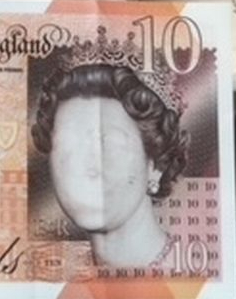 "After a Sri Lanka Polymer Rs200 with no printing on one side was listed on eBay in 2020 June, I investigated
and found that there were many reports in the press with How-To videos on YouTube.
"After a Sri Lanka Polymer Rs200 with no printing on one side was listed on eBay in 2020 June, I investigated
and found that there were many reports in the press with How-To videos on YouTube.
"I erased an Rs200 note clean myself and wrote up with comments from experts.
"The Missing Queen on polymer note was a frequent fake error note that was sold on eBay at that time. Don't see any now. As the Fakes are exposed the remainder were probably put back into circulation."
See:
Plastic £5 banknote 'can be rubbed out', says printer
(https://www.heraldscotland.com/news/14828549.plastic-5-banknote-can-be-rubbed-out-says-printer/#)
New 'Durable' £5 Note Can Be Wiped Clean With A Pencil Eraser
(https://www.youtube.com/watch?v=zQBVrmcPjb0)
1998 - Sri Lanka - 200 rupee banknote
Polymer Substrate
(http://notes.lakdiva.org/commemorative/1998_ind50_200r_polymer.html)
Thanks! -Editor
To read the earlier E-Sylum article, see:
£10 NOTE MISSING QUEEN'S FACE
(https://www.coinbooks.org/v24/esylum_v24n13a30.html)
David Pickup writes:
"Britain is set to give up decimalisation and return to pounds shillings and pence. The fifty year long experiment has been a success but it is now time for change in Brits' pockets.
"The old denominations will be reintroduced gradually over 1st April which will now be called A Day. If all goes well we may return to Libra solidus and denarius. Instead of coins being marked "new pence" will now be "new old pence" or "old new pence".
"Authorities are also thinking of reintroducing those handy denominations that were so popular such as the third and quarter farthing, 1 1/2 pence and Cartwheel twopence. If goes well they will re-introduce the noble and angel.
"It is to be hoped that other countries will return to pre decimal currency. The USA may adopt the same system and perhaps our European friends will keep the euro but have twelve schillings and 240 pfennigs/centimes. "
Yeah, that's going to happen... -Editor
LOVE TOKENS ON COUNTERFEIT SEATED QUARTERS
Jeremy Bostwick submitted these notes on the mysterious lettered love tokens on counterfeit Liberty Seated Quarters. Thanks! -Editor
Regarding the mysterious love token on a fake Seated Quarter, this is actually something that I have been looking into since last summer when I acquired one with a "P." I thought that it was just odd in that it was a love token on a counterfeit, but looking at it more, it seemed not be engraved on the reverse. I then discovered a second one on the archives of the Seated Liberty collector site (this time with an "S," but otherwise the same style, with the same obverse die. I wrote to them about it, and my note was published (on page 24 of the August 2020 E-Gobrecht).
Since then, I have acquired another example, this time with a "K." Notice the similarities. There is also yet another on eBay now (with an "F"):
I had a conversation with someone at Northeast Numismatics regarding it about a week ago. I think that an enterprising jeweler looked to capitalize on the love token market, and instead of making individual ones on real host coins, instead made a fake die, cast his own, with varying reverses pre-made with the maeander border and old English-style letter. Almost like those novelty small license plates with people's names on them that you see in gift stores. I think that this was someone's cottage industry, and they're finally being recognized. I'll be interested to see what others have to say.
See also:
1861
Counterfeit 105
Obverse 5: Hand Cut Die - Small Date
Reverse F: Love Token Reverse
(http://www.lsccweb.org/cfquarters/1861_105page.htm)
1861 ON QTR LOVE TOKEN, SEE PICTURES L288
(https://www.ebay.com/itm/1861-ON-QTR-LOVE-TOKEN-SEE-PICTURES-L288/154396218625)
To read the earlier E-Sylum article, see:
NOTES FROM E-SYLUM READERS: MARCH 28, 2021 : Love Token on Counterfeit Seated Quarter
(coinbooks.org/v24/esylum_v24n13a11.html)
MANSHIP'S DIANA AND FLIGHT OF EUROPA
Bob Mueller submitted this article on the works of artist Paul Manship. Thanks! -Editor
From Medals to Monuments
Paul Manship's Diana and Flight of Europa
First and foremost, I would like to dedicate this submission to the memory of Dick Johnson and Joe Levine, whose recent passing within two months of each other has been heavy on my heart and left a palpable void in the medallic art community.
The current exhibition "Paul Manship: Ancient Made Modern" at the Wadsworth Atheneum focusing on his artistic development is the impetus for this brief essay, since, as pointed out in the last issue of The E-Sylum, his medallic work was basically overlooked.
In fact, two of Manship's most popular sculptures can trace their beginnings to "medallic" works by the artist. Both of these found their beginnings in what the late Sam Pennington coined as "medallic ashtrays." The first, Diana, from the pair Diana and Actaeon was cast in several sizes from moderate to monumental. Though only one half of the pair, the origin of this goddess can be traced to the earliest of Manship's bronze plates executed in 1915.
The National Sculpture Society commissioned the artist to create a small bronze ashtray to be presented to its lay members, which numbered 145 at the time. Manship's choice of the goddess Diana resulted in a delightful gem in that became the first of a series illustrating mythological scenes and astrological signs.
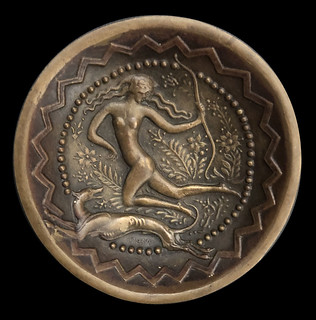 Observing the Diana Ashtray, the viewer is initially taken by the great illusion of
motion and speed. Diana with her bow literally flies through the surrounding flora,
her swiftness easily matches the speeding hound beneath her. The foliage gives way
to the envelope created before her while the plants behind are drawn in her wake.
Her figure is freely modeled and extremely fluid in form, her long hair flowing in
serpentine waves on both sides of her head. The style of the figure itself is
reminiscent of early Minoan frescoes and everything about it insinuates action.
Observing the Diana Ashtray, the viewer is initially taken by the great illusion of
motion and speed. Diana with her bow literally flies through the surrounding flora,
her swiftness easily matches the speeding hound beneath her. The foliage gives way
to the envelope created before her while the plants behind are drawn in her wake.
Her figure is freely modeled and extremely fluid in form, her long hair flowing in
serpentine waves on both sides of her head. The style of the figure itself is
reminiscent of early Minoan frescoes and everything about it insinuates action.
The hound in comparison exudes pure physical power. Its musculature is clearly defined and we can feel the strength and lightning speed of this magnificent beast as he adoringly races at his mistress' side. Both are encircled, but not completely contained within a raised beaded border forming a divine mystical nimbus; lending the illusion that they might at any moment leap from the confines of the bowl. This border is then contained within a second zig-zag motif just inside the rim, adding even more energy to this dynamic composition.
Around the outside rim of the bowl runs the inscription, the lettering of which is well designed and quite creative. It reads "FROM•THE•NATIONAL•SCULPTURE• SOCIETY•TO•ITS•LAY•MEMBERS• MCMXV." The piece is signed around the base PAUL MANSHIP•SC•©, and is also signed inside the bowl •PHM• making this only one of two works to be signed on both sides by the artist. Each example was cire perdu cast by Roman Bronze Works as indicated by a seal stamped into the base of the bowl.
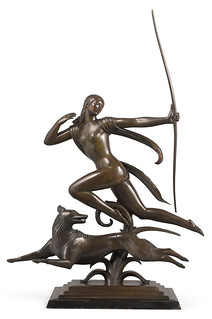 In 1921 the figure of Diana made its more formal debut, though Actaeon would not
be realized until two years later. Manship was an avid wine aficionado and the
enactment of the Volsted Act in October 1919 precipitated a move to Europe in
1921 that would last three and a half years. A short time in England was followed by
a move to Paris and it was here that the paired works came to fruition.
In 1921 the figure of Diana made its more formal debut, though Actaeon would not
be realized until two years later. Manship was an avid wine aficionado and the
enactment of the Volsted Act in October 1919 precipitated a move to Europe in
1921 that would last three and a half years. A short time in England was followed by
a move to Paris and it was here that the paired works came to fruition.
The relocation to Paris energized the sculptor as he wrote to his friend Barry Faulkner: "Paris is the center of the world—and while I am not in the center of the whirlpool I feel the motion of it;" and later "My coming here is no mistake—I feel inspired to go ahead—and I hope to see my own ideas more clearly and to carry out my work in better form." 1
John Manship wrote in his father's biography: "the most important pieces that Manship did during these Paris years were the Diana and Actaeon.... These pieces represent Manship at his most characteristic, with their use of mythological subjects, nude figures in motion, stylized animals and plants, and highly decorative patterns in which the voids are as calculated for effect as the solids. These two pieces have always been—along with Dancer and Gazelles—Manship's most popular works." 2
The other work to find its genesis in the humble and utilitarian form of an ashtray was The Flight of Europa of 1925.
Isabel Stewart Gardner, the grande dame of Boston society, owned Titian's 1562 masterpiece, Rape of Europa, which inspired the sculptor to create the Flight of Europa Ashtray in 1917 for her. The sculptor met the heiress through a mutual friend, Denman Ross, and presented her with one of his Jeanne d'Arc medals as a gift. In response she wrote an effusive letter to the artist: "I carry it around with me everywhere, my ‘paperweight.' Looking at it and feeling it give me so much pleasure. Oh it is too beautiful! Jeanne d'Arc is one I love and this is the best of her I know... I do not need a reminder of you, whom I have so near my heart. May the future bring us oftener together." 3
 The 5 1/2 inch dish reveals the scene of Europa being abducted by Zeus in the form of
a bull and carried off over the sea to carry out his lustful intentions with her. As in
the Diana Ashtray, this work conveys a dynamic sense of motion, as well as one of
unveiled sensuality, as well as deriving its stylistic inspiration from early Minoan
frescoes. Europa, barely able to keep astride the powerfully muscled bull clings to an
ear, her right leg trailing behind as she is jounced atop the racing animal. Her
diaphanous garment blows away in the wind of their flight, revealing her ample
feminine charms. The bull, exudes power and masculinity, covered in thick muscle,
its penile sheath quite obvious, it runs completely airborne in full stride hurrying to
consummate the lustful act. Beneath the bull swim four dolphins in escort, much as
they do when confronting a ship. Finally the group is surrounded by a severe wave
motif border which runs around the flat perimeter of the dish that gives the
impression of wind moving at great speed over the water.
Manship wrote to Mrs. Gardner on Christmas Day that year:
The 5 1/2 inch dish reveals the scene of Europa being abducted by Zeus in the form of
a bull and carried off over the sea to carry out his lustful intentions with her. As in
the Diana Ashtray, this work conveys a dynamic sense of motion, as well as one of
unveiled sensuality, as well as deriving its stylistic inspiration from early Minoan
frescoes. Europa, barely able to keep astride the powerfully muscled bull clings to an
ear, her right leg trailing behind as she is jounced atop the racing animal. Her
diaphanous garment blows away in the wind of their flight, revealing her ample
feminine charms. The bull, exudes power and masculinity, covered in thick muscle,
its penile sheath quite obvious, it runs completely airborne in full stride hurrying to
consummate the lustful act. Beneath the bull swim four dolphins in escort, much as
they do when confronting a ship. Finally the group is surrounded by a severe wave
motif border which runs around the flat perimeter of the dish that gives the
impression of wind moving at great speed over the water.
Manship wrote to Mrs. Gardner on Christmas Day that year:
"Mrs. Manship joins me in wishing you the very best of Merry Christmases. And are sending you this little tray as a trifling remembrance of your many kindnesses to us... Mr. Titian has proved that Europa & the Bull is a great subject. This relief is to try out the subject for composition. How do you think it will work out in the round, I want to try it." 4
It appears clear that Manship's intent was to work this ‘sketch' into something more definitive, and it would not be until 1925 that he realized this thought with his Flight of Europa. The work is a successful composition but fails to capture the sensual energy and excitement of the abduction as does the earlier bronze dish. In contrast to Diana, Europa appears a bit campy, as she listlessly sits atop the bull with Eros whispering in her ear. The leaping dolphins are paired here and emphasize motion, as well as the fully extended bull, adding to the sense of speed and excitement. In his catalogue raisonné on the artist, Edwin Murtha included this notation for the work: "Manship's Flight of Europa is very likely Minoan in inspiration, yet his strong personal style has produced a wholly original work. it is interesting to compare his version of the subject with those of his contemporaries [Antoine] Bourdelle and [Carl] Milles. Bourdelle's little sketch is a work of considerable power despite its size. Milles bronze Europa and the Bull vibrates with drama and nervous movement, the very opposite of the understated mood of Manship's piece. The story of Europa and the Bull, something of an impious parody on the weaknesses of the gods, receives in Manship's version the light touch and restrained humor it needs." 5
The Europa Ashtray was a piece that saw several incarnations throughout Manship's career. By 1919, while retaining the same basic composition, the piece had already evolved into something resembling its final state. The most noticeable changes are the absence of the dolphin on the far right, the strengthened tail flukes of the remaining three and the forward thrusting horns of the bull, which now break free into the encircling wave motif. The dish still retains some archaic qualities but the modeling is less stylized and more naturalistic, lending a softer and more sensual appearance. In 1946, Flight of Europa achieved its final state with slight refinements in the modeling and the inclusion of an additional fold in the drapery over Europa's thigh.
There are themes that run through Manship's corpus of work—especially Pegasus—who appears on a number of medals, large reliefs and sketches, though none form the inspirational basis for a major work. Each is an expression unto itself. The two works examined here literally "rise from the ashes" to give us a look into Manship's creative process; ascending from humble beginnings to stand today as an enduring testament to his genius.
Notes:
1 Manship, John; Paul Manship; Abbeville Press, NY, 1989 p. 97
2 Ibid; p. 101
3 Ibid; p. 79
4 Hancock, Walker, Paul Manship, Fenway Court, vol. 1 no 1, Boston, 1966
5 Murtha Edwin, Paul Manship; Macmillan Company, NY, 1957 p. 164
To read the earlier E-Sylum article, see:
PAUL MANSHIP EXHIBIT
(https://www.coinbooks.org/v24/esylum_v24n13a34.html)
VOCABULARY TERM: DEBONDED, DEBONDING
Here's another entry from Dick Johnson's Encyclopedia of Coin and Medal Terminology. This is a short one, but I thought it would be a good follow-on to last week's entry on clad coinage; specifically, what happens when the cladding comes apart - either by mistake or on purpose. I added an image from Error-Ref.com. -Editor
Debonded, Debonding. The separation of an outer clad layer of metal either before or after striking. It is caused by poor adhesion during the bonding process. On a struck piece debonding is considered a clad metal anomaly because of the incorrect preparation of the strip and planchet. It would be described in numismatic literature as a lamination error. The purposeful debonding (as with skeleton scrap) to recycle the metal is accomplished by heating the clad strip to a specific temperature, holding the metal at that temperature until the bond weakens, then physically pulling apart the separate layers.
To read the Error-Ref.com article, see:
Struck Clad Layer: Split Off After Strike
(http://www.error-ref.com/struck_clad_layer_split_off_after_strike/)
To read the complete entry on the Newman Numismatic Portal, see:
Debonded, Debonding
(https://nnp.wustl.edu/library/dictionarydetail/515672)
To read the earlier E-Sylum article, see:
VOCABULARY TERM: CLAD, CLADDING
(https://www.coinbooks.org/v24/esylum_v24n13a13.html)
JOSEPH NAPOLEON TRICOT LEVICK (1828-1908)
Here's another entry from the online draft of John Lupia's book of numismatic biographies. Thanks! This is an excerpt with the full article and bibliography available online. This week's subject is American numismatic giant J.N.T. Levick. -Editor
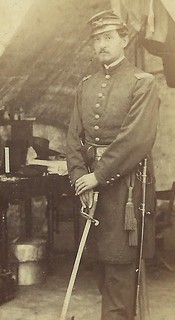 Joseph Napoleon Tricot Levick (1828-1908), was born in New Orleans, Louisiana. However the GAR Muster Roll of December 16, 1892 lists him as 58 years of age making him born in 1834.
Joseph Napoleon Tricot Levick (1828-1908), was born in New Orleans, Louisiana. However the GAR Muster Roll of December 16, 1892 lists him as 58 years of age making him born in 1834.
About 1855, he moved to Philadelphia, Pennsylvania, and a member of that city's and the nation's first numismatic club – the Philadelphia Numismatic Society. He worked in an office on Front Street in the same building where Ebenezer Locke Mason, Jr., also worked. The two became good friends socially and in coin and stamp collecting.
During the Civil War Levick enlisted as a private on April 19, 1861, and subsequently was mustered in on June 15, 1861, at Philadelphia, Pennsylvania as a 2nd Lieutenant. He had previously been a private for 30 days in Company "H", 7th New York Militia. On June 20, 1861, he was assigned to Company "I", 70th New York Volunteer Infantry Regiment, Sickle's Brigade (a.k.a. the 1st Excelsior Regiment of the Excelsior Brigade). He was promoted to First Lieutenant on April 30, 1862. On May 5, 1862 he saw action for the first time at Fort MacGruder. The next day he was brevetted to Captain for conspicuous gallantry in battle. Levick was discharged on May 18, 1863, with the rank of 1st Lieutenant.
In 1860 he moved to New York and was an agent for Woodgate & Company, importers of liquor, wines, gins, etc., at 83 Water Street.
 He issued a brass store card with his name on the reverse. He also seems to have been a dealer in Regalias tobacco and cigars with a token "The Smoker" NY-429, with an address at 904 Broadway, New York.
He issued a brass store card with his name on the reverse. He also seems to have been a dealer in Regalias tobacco and cigars with a token "The Smoker" NY-429, with an address at 904 Broadway, New York.
He was a charter member of the Numismatic and Archaeological Society of Philadelphia. He served in the U. S. Army during the Civil War and obtained the rank of captain. In the summer of 1863, twenty-seven Oak and Pine Tree coins were unearthed in Roxbury. These came into the possession of J.N.T. Levick, and would appear at W. Elliot's auction the following year. During the Restoration in 1864 he moved to New York working as a banker.
His 1865 coin auction catalog was postponed due to the assassination of Abraham Lincoln on April 14th.The sale was held on May 29, 1865 and realized $2,090.03. Sold his collection of 1667 lots through Bangs 41 page catalog on 05/29/1865.
In December 1865, he joined the ANS.
In March 1866 he proposed the first numismatic journal in the United States – the American Journal of Numismatics – and served as its first editor. Publication of the AJN began in May 1866. In addition, he also served the ANS as its treasurer, a position he held from 1867 to 1875.
In October 1868 he published a survey of 1793 cents.
In April 1869 Levick and Sylvester Crosby, produced an article describing the 1793 varieties and a plate depicting the various obverses and reverses.
 In January of 1870 he opened a bank in the same building as Mason at 54 Wall Street. That same year he helped form the New York Numismatic Society. Some months afterwards the Society merged with the American Numismatic Society to form the American Numismatic and Archeological Society. Levick continued as a member of the combined organization.
In January of 1870 he opened a bank in the same building as Mason at 54 Wall Street. That same year he helped form the New York Numismatic Society. Some months afterwards the Society merged with the American Numismatic Society to form the American Numismatic and Archeological Society. Levick continued as a member of the combined organization.
Levick sold his collection of tokens, which included more than 20,000 pieces, in 1884. He observed and discovered various varieties of the 1793 Large Cent and prepared a table published in his N. Y. Journal of Numismatics. He was perhaps the first to refer to the edge impression on the 1793 Large Cent as Vine and Bars instead of the Stripes and Bars assumed by the general numismatic community.
In April 1892 he was taken very ill as it was reported in the May 15, 1892, issue of The Post Office, on page 21 : "We understand that Mr. J. N. T. Levick has been quite sick, and he is now in North Carolina for his health."
On December 16, 1892 he mustered in GAR (Grand Army of the Republic) pension.
New York City Directories from 1888-1894 list him living at 244 East 86th Street, working in insurance at 54 William Street.
In 1898, he was on the Executive Committee of the Collector's Club in New York, together with Hiram E. Deats and Henry L. Calman.
Letter to Tom L. Elder, 1907, published by Elder in The Elder Monthly, June-July 1907 :
Some day there will be a grand house cleaning and the junk man and the scavenger will have a cinch shoveling all my gatherings for the last 50 years. There's no man in my neighborhood can boast of such a collection as my tin foils, wrappers, graphics, beers (unbottled), cigarettes, (smokeless), and tax paids. Then I must have a hogshead of entire embossed envelopes saved for forty years past; theatre play bills, programmes, photographs, car and ferry tickets, 30 to 40 years old; 200,000 or more postmarks with stamps attached; engravings, philatelic literature, numismatic library, coins and stamps, catalogues- let alone match and medicine and other revenues; U S Postage, plate numbers. Then there are books, books, books, from one end of the house to the other. I want the numismatic, philatelic, and curio world to know that I have to throw up the sponge and be counted out.
He died on Monday, September 7, 1908. He was survived by his wife Mary Louise Gardiner Levick (1827-). Funeral services were held September 9, 1908 at 7:30 PM at the Chapel of the Holy Trinity Church East 88th Street, between 1stand 2nd Avenues, Manhattan, New York. His death notice was published in The New York Times, Tuesday, September 8, 1908, page 9.
In June 2018, the ANA inducted him into the ANA Hall of Fame.
To read the complete article, see:
LEVICK, JOSEPH NAPOLEON TRICOT
(http://www.numismaticmall.com/numismaticmall-com/levick-joseph-napoleon-tricot)
To read earlier E-Sylum articles, see:
ARTICLE EXPLORES THE 1869 AJN LEVICK PLATE OF 1793 CENTS
(https://www.coinbooks.org/esylum_v11n34a07.html)
ARTICLE HIGHLIGHTS JOSEPH N. T. LEVICK'S MILITARY SERVICE
(https://www.coinbooks.org/esylum_v11n36a25.html)
J.N.T. LEVICK INDUCTED TO ANA HALL OF FAME
(https://www.coinbooks.org/v21/esylum_v21n31a20.html)
2022 NYINC EDUCATIONAL PROGRAMS
Additional numismatic education events have been announced for the next New York International. Here's the latest press release. -Editor
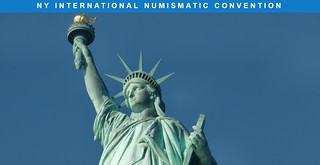 The educational presentations at the January 7-16, 2022 50th Annual New York International Numismatic Convention, to be held at the Grand Hyatt New York, located at 109 East 42 nd Street have been broadened to include a lecture by New York Numismatic Club member and Past President Jai Chandrasekhar, The Life and Work of French Medal Maker and Sculptor Alexandre Charpentier. In addition to his work as a medallist and sculptor, Charpentier was also a cabinet and furniture maker and worked in tin, marble, wood, leather and terra cotta. He lived from 1856-1909.
The educational presentations at the January 7-16, 2022 50th Annual New York International Numismatic Convention, to be held at the Grand Hyatt New York, located at 109 East 42 nd Street have been broadened to include a lecture by New York Numismatic Club member and Past President Jai Chandrasekhar, The Life and Work of French Medal Maker and Sculptor Alexandre Charpentier. In addition to his work as a medallist and sculptor, Charpentier was also a cabinet and furniture maker and worked in tin, marble, wood, leather and terra cotta. He lived from 1856-1909.
Mr. Chandrasekhar graduated from Yale University in 1987 and went on to earn his Juris Doctor degree from Yale Law School in 1997, where he was the Book Review Editor for the Yale Law Journal. In the course of his legal career he has served as a Staff Attorney with the Enforcement Division of the Securities and Exchange Commission. Prior to his SEC service he was with the firm of Sullivan and Cromwell LLP. He currently serves as Senior Counsel for Bernstein Litowitz Berger & Grossman LLP. A member of the New York City and New York State Bar Associations, he serves as Secretary of the New York County Lawyers Association.
He is a collector of French and British medals, coins and banknotes and is the author of an article about the French medal engraver Raymond Gayrard that appeared in the ANS Magazine.
Mr. Chandrasekhar's program is scheduled for 4:15pm on Friday, January 14 in the Julliard Room at the Grand Hyatt. Overall NYINC activities get underway on Friday, January 7 with the opening of auction lot viewing. Auction sessions will be held each day from Sunday, January 9-Sunday, January 16. The world and ancient specialty bourse will operate from Thursday, January 13-Sunday, January 16. Full NYINC details, including the schedule of events, hotel reservation information and a listing of booth holders can be found on the convention website, www.nyinc.info.
Here's more from earlier press releases we hadn't discussed in The E-Sylum yet. -Editor
The 50th Annual New York International Numismatic Convention, ... will include an educational presentation by widely known numismatic researcher, writer and lecturer Dr. Ursula Kampmann. Dr. Kampmann's presentation will be The Evolution of the German Coin Market After 1970. She will speak at 11am on Friday, January 14 in the Julliard room of the Grand Hyatt.
Kevin Foley, Bourse Chairman for the NYINC said, "Dr. Kampmann's participation as a presenter at our 50th annual NYINC will materially enhance the strength of our educational programs. In addition to serving as a past secretary for the International Bureau for the Suppression of Counterfeit Coins, she founded and currently directs the widely acclaimed educational and news website www.coinsweekly.com, is a fellow of the American Numismatic Society and since 2002 editor of MuenzenRevue."
Foley continued, "Her recognitions include the 2002 Vreneli Prize of the Society for International Monetary History, the Otto-Paul-Wenger Award from the Association of Swiss Professional Numismatists in 2012 and the Burnett Anderson Award for Excellence in Numismatic Writing from the American Numismatic Association in 2015. In addition to her considerable research and academic achievements she also has a long record as a commercial participant in the numismatic trade. Her presentation is one that our 2022 attendees will certainly benefit from."
The roster of educational presentations ... [also includes] a program by Dr. Bruce Smart, Collecting World Paper Money: Banknotes of the Belgian Congo.
A graduate of the University of Missouri at Kansas City, Smart went on to earn a Ph.D. in chemistry in 1970 from the University of California at Berkley. He had a 35 year career as a scientist and in corporate research management for the DuPont Company, retiring in 2005. Dr. Smart is a 53 year member of the American Chemical Society and a Fellow of the American Association for the Advancement of Science.
Dr. Smart's collecting interests started in 1995 and he began a specialization in world notes in 2000. He has served as a consultant, cataloger and show representative for R.M. Smythe and Company as well as Spink USA. He currently consults for Heritage Numismatic Auctions. He is a member of the International Bank Note Society, the Society of Paper Money Collectors and the New York Numismatic Club. Spink & Sons has held two charity auction sales of his banknote collections: "The Bruce Smart Collections of the Middle East & North Africa" in 2016 and "The Bruce Smart Collections of British Commonwealth – Parts One & Two" in 2017.
He continues to collect Kansas City. Missouri national banknotes as well as adding to his major collection of Belgian Congo material. His reading interests focus on Central African exploration in the 19th century.
To read the earlier E-Sylum article, see:
2022 NYINC NUMISMATIC MEDIA PANEL DISCUSSION
(https://www.coinbooks.org/v24/esylum_v24n09a19.html)
MORE ON NON-FUNGIBLE TOKENS
When I first saw the news article about the basketball platform Top Shot, I thought it would make a great "decoy" article for last week's April Fool E-Sylum issue - something true, but so out-there-sounding, that people would think it's a joke. But I guess nothing fazes people anymore. Non-Fungible Tokens (NFTs) may or may not be here to stay, but they're certainly the craze of the moment. NFTs or something like them may well eventually worm their way into the numismatic world. -Editor
Joel Orosz writes:
"I had not heard of NFTs before, and I must confess that I am among those chowderheads who just don't get it. Blockchain technology guarantees that you own an authentic, albeit virtual, video clip that can be viewed for free on the Internet. Wouldn't this be like paying $208,000 to virtually own Pledges of History, which can be viewed for free on NNP? I paid less than 1% of that to own two differently-inscribed copies of the same book. I didn't get blockchain verification straight back to 1846, however, so perhaps I was literally taken for a ride by not having two virtual books blockchain-backed instead of two literally signed-by-the-author ones. "
Kavan Ratnatunga writes:
"The Token can be programmed to give the original creator a commission, if and when the digital art is resold."
Correct. In addition to authenticating ownership, the token can embed contract terms for future resales. This comes from the original concept of enabling the original creator to profit from future sales of their work. It's like a covenant on a deed. Of course, if you don't agree to that covenant, don't buy the item, or don't pay as much as you would otherwise.
Here are some article links courtesy Kavan, Martin Kaplan, and myself. -Editor
For more information, see:
Non-fungible token
(https://en.wikipedia.org/wiki/Non-fungible_token)
What's A Non-Fungible Token? Why Some Collectors Are Spending Millions On Them
(https://www.npr.org/2021/03/05/973929514/whats-a-non-fungible-token-why-some-collectors-are-spending-millions-them)
NFTs, explained
(https://www.theverge.com/22310188/nft-explainer-what-is-blockchain-crypto-art-faq)
From Crypto Art to Trading Cards, Investment Manias Abound
(https://www.nytimes.com/2021/03/13/technology/crypto-art-NFTs-trading-cards-investment-manias.html)
Here's a lengthy excerpt from a great New York Times article about NFTs by Kara Swisher. -Editor
For those scratching their heads about the latest tech phenom called non-fungible tokens, or NFTs, I have one simple sentence to explain it all: Everything that can be digitized will be digitized.
It was the same explanation I gave as the internet first went commercial in the early 1990s, when I started writing about the nascent medium. I was often asked the same questions by people who often thought of it as a fad: What exactly was on the internet? And why would I use it?
Everything, I answered, to the first question. All knowledge. All communications. All entertainment. All movies. All commerce.
To the second question, well, my answer was usually: Whatever.
With NFTs, we've come yet another step closer to fully digitizing our lives. Like the internet, they are complex, but in the simplest terms, they are digital files that are stored using a technology called blockchain, which is essentially a digital ledger. But unlike cryptocurrencies, including the well-known Bitcoin, NFTs are not interchangeable with one another, because of their unique digital assets as well as important digital authentication that marks ownership.
The easiest analog comparison many make is to baseball cards, some of which are valuable and some not.
Anything that someone might find valuable that can be digitized can become an NFT — and be sold in any of the many crypto marketplaces. This includes video clips of sports events, tweets to photos and even things like rights to front-row seats at concerts.
NFTs have shown their utility most prominently recently in the art world, where people are paying enormous sums for the rights to "own" things, like a one-of-a-kind GIF of the famous Nyan Cat or a whimsical and often puerile collection of digital art images made by a popular graphic designer named Mike Winkelmann, who goes by Beeple.
"It's a blank slate" is how Beeple described NFTs to me in an interview, never mind that bizarre images of a naked Elon Musk and a lactating Donald Trump, which have driven art critics crazy, are how he has chosen to fill his.
And that's pretty much all you need to know, since you can pour anything of value into an NFT — even assets linked to the real world like houses and cars — and it will be worth whatever it is worth, which has always been whatever someone is willing to pay to acquire it. Most important, it is verified and transparent.
It's also the obvious next step as our world becomes ever more virtual. This irresistible trend has accelerated with great speed over the course of the pandemic, which has forced us to work online, play online, watch online, talk online, exercise online and learn online more than ever before.
And that behavior is simply not going to let up. So, repeat after me: Everything that can be digitized will be digitized. And it will happen before you know it.
To read the complete article, see:
Another Big Step Toward Digitizing Our Lives
(https://www.nytimes.com/2021/03/19/opinion/NFTs-beeple-crypto.html)
Some of those sky-high prices are already slipping... -Editor
Prices for digital collectibles like art and sports memorabilia are sliding, turning the focus back on whether the nascent market for so-called non-fungible tokens is any more than a fleeting mania.
Average prices for NFTs -- essentially tradable digital certificates that use blockchain technology to prove ownership and provenance of online assets -- have tumbled almost 70% from a peak in February to about $1,400, according to Nonfungible.com, which tracks a variety of NFT marketplaces.
A burst of interest in NFTs hit a peak last month when a digital artwork by Beeple sold for a staggering $69.3 million. For some, that sum showed NFTs were in the grip of investor excess in a world full of stimulus, and destined to fizzle. Others who study the technology argue the use of blockchain to create scarcity for digital collectibles is a lasting innovation rather than a price fad.
"It's not meaningful to characterize a concept as a financial bubble," said Chris Wilmer, a University of Pittsburgh academic who co-edits a blockchain research journal. "‘NFTs' aren't in a bubble any more than ‘cryptocurrency' is a bubble. There will be manias and irrational exuberance, but cryptocurrency is clearly here to stay with us for the long term and NFTs probably are too."
"The interest in building a persona -- and owning things -- in the digital world has been bubbling up for years," said Berna Bershay, an analyst at Empire Financial Research. "With so much time spent online in the past year, the desire to own digital assets was probably dragged several years forward by the Covid-19 crisis."
To read the complete article, see:
NFT Price Crash Stirs Debate on Whether Stimulus-Led Fad Is Over
(https://www.bloomberg.com/news/articles/2021-04-03/nft-price-crash-stirs-debate-on-whether-stimulus-led-fad-is-over)
This piece from The Atlantic provides a perspective from one of NFT's creators. -Editor
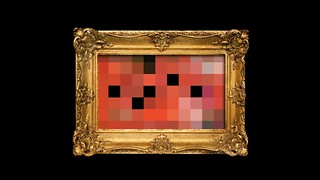 The only thing we'd wanted to do was ensure that artists could make some money and have control over their work.
The only thing we'd wanted to do was ensure that artists could make some money and have control over their work.
The idea behind NFTs was, and is, profound. Technology should be enabling artists to exercise control over their work, to more easily sell it, to more strongly protect against others appropriating it without permission. By devising the technology specifically for artistic use, McCoy and I hoped we might prevent it from becoming yet another method of exploiting creative professionals. But nothing went the way it was supposed to. Our dream of empowering artists hasn't yet come true, but it has yielded a lot of commercially exploitable hype.
If you liked an artwork, would you pay more for it just because someone included its name in a spreadsheet? I probably wouldn't. But once you leave aside the technical details of NFTs, putting artworks on the blockchain is like listing them in an auction catalog. It adds a measure of certainty about the work being considered. By default, copies of a digital image or video are perfect replicas—indistinguishable from the original down to its bits and bytes. Being able to separate an artist's initial creation from mere copies confers power, and in 2014 it was genuinely new.
Our initial NFT demo in 2014 was so well received that McCoy and I were invited to present the tech again a week or two later—this time at TechCrunch Disrupt NY, one of the technology industry's highest-profile conferences. The crowd was a mix of tech geeks and corporate types, all eager to spot the next hot start-up or popular smartphone app. McCoy and I gave a slightly more polished demo of how our proto-NFTs could help artists. Just like at the art museum, we made fun of our own phrase, monetized graphics. This time, nobody in the audience laughed. In the tech world, monetizing innovations is no joke. It's how the industry operates, and this crowd was all business.
But the NFT prototype we created in a one-night hackathon had some shortcomings. You couldn't store the actual digital artwork in a blockchain; because of technical limits, records in most blockchains are too small to hold an entire image. Many people suggested that rather than trying to shoehorn the whole artwork into the blockchain, one could just include the web address of an image, or perhaps a mathematical compression of the work, and use it to reference the artwork elsewhere.
We took that shortcut because we were running out of time. Seven years later, all of today's popular NFT platforms still use the same shortcut. This means that when someone buys an NFT, they're not buying the actual digital artwork; they're buying a link to it. And worse, they're buying a link that, in many cases, lives on the website of a new start-up that's likely to fail within a few years. Decades from now, how will anyone verify whether the linked artwork is the original?
All common NFT platforms today share some of these weaknesses. They still depend on one company staying in business to verify your art. They still depend on the old-fashioned pre-blockchain internet, where an artwork would suddenly vanish if someone forgot to renew a domain name. "Right now NFTs are built on an absolute house of cards constructed by the people selling them," the software engineer Jonty Wareing recently wrote on Twitter.
Meanwhile, most of the start-ups and platforms used to sell NFTs today are no more innovative than any random website selling posters.
To read the complete article, see:
NFTs Weren't Supposed to End Like This
(https://www.theatlantic.com/ideas/archive/2021/04/nfts-werent-supposed-end-like/618488/)
Here's an excerpt from Jeff Garrett's article om the topic. -Editor
For several years now, I have joked that people know so little about Bitcoin that they ask my thoughts on it because I'm a coin dealer. In general, most individuals that I speak with consider Bitcoin to be a speculative bubble waiting to pop. The recent rise of Non-Fungible Tokens (NFTs) is making peoples' heads spin, but the future of NFTs is up in the air until the tokens become more widely accepted and understood as an asset class.
Many of you are probably wondering what any of this has to do with the rare coin market. My guess is, probably more than most of us realize.
Most large Wall Street firms have created departments for cryptocurrency investments, and many large corporations now park excess funds in Bitcoin instead of in gold or foreign exchange. Elon Musk recently invested more than $1 billion in Bitcoin for Tesla. Bitcoin is outshining gold, and the flow of capital proves this: follow the money.
The NFTs phenomenon is another matter. Many people in the rare coin industry are trying to figure out if there could be a play in this space. My expertise and understanding of the NFT markets is limited, but I do know the technology is based on blockchain and the security it provides. Artists and players in the art market are extremely excited by the possibilities NFTs might offer those who seek to retain some rights in future sales of their works.
Perhaps this could be applied to rare coins in some way. The fractional sale of mega-coins or collections could be another possibility. Who wouldn't want part ownership of the 1787 Brasher Doubloon graded NGC MS 65 that recently sold for $9.36 million? This new way of looking at rare coin investing could bring in giant sums and attract a much younger demographic.
To read the complete article, see:
Jeff Garrett: Cryptocurrency, Non-Fungible Tokens and the Rare Coin Market
(https://www.ngccoin.com/news/article/8994/cryptocurrency-rare-coin-market/)
So what will the idea morph into in the future? I agree that it's a powerful idea, to both reliably authenticate ownership and perpetuate contracts into the future, returning some compensation to the original creators or their successors. Great for starving artists and their families, but also a great way for the rich to get richer and richer for ever and ever. What if Vincent Van Gogh (or a trust in his name) continued to collect a portion of the proceeds every time one of his artworks were resold? What if I could claim a portion of the proceeds every time one of the coins in my collection today trades hands again in the future? -Editor
To read the earlier E-Sylum article, see:
VIRTUAL MARKET ENJOYS ASTONISHING SUCCESS
(https://www.coinbooks.org/v24/esylum_v24n13a32.html)
WORLD BANKNOTE AUCTIONS SALE 7 HIGHLIGHTS
Here are some highlights from the upcoming World Banknote Auctions sale. -Editor
 World Banknote Auctions Premier Sale 7 is listed now and has live bidding on our website and through our mobile apps on April 15th at 10 AM PST. This sale features highlights from around the world, including a great group of Canada and a strong British Commonwealth collection, highlighted by the sole PMG graded uncirculated example of an issued British Caribbean Territories $20.
World Banknote Auctions Premier Sale 7 is listed now and has live bidding on our website and through our mobile apps on April 15th at 10 AM PST. This sale features highlights from around the world, including a great group of Canada and a strong British Commonwealth collection, highlighted by the sole PMG graded uncirculated example of an issued British Caribbean Territories $20.
Lot 7053: 1963 British Caribbean Territories $20
Graded Gem Uncirculated PMG 65 EPQ (lot 7053), this amazing note is fresh to the market. It was brought to Canada by an immigrant from Barbados in the 1960s (along with several other lower denominations listed in the sale) and has been kept in the same family since. It was consigned by us by the dealer who purchased the collection from the family and these notes have never been offered to the collector community until now. A survey of auction records and dealer's price lists going back to the 1980s has revealed no other examples of this note ever appearing on the market in this grade level. It carries an estimate of $15,000-$18,000.
To read the complete lot description, see:
British Caribbean Territories 2.1.1963 P-11b PMG Gem UNC 65 EPQ 20 Dollars
(https://www.worldbanknoteauctions.com/lots/view/4-241LZP/british-caribbean-territories-211963-p-11b-pmg-gem-unc-65-epq-20-dollars)
Lot 7072: 1935 Canada French $50
The Canadian selection is highlighted by a wonderful uncirculated example of the French language 1935 $50 graded Choice Uncirculated 63 by PMG. One of the key notes in the small-size Canadian series, just 32,500 were printed, versus 131,000 that were printed for the English variety (the 1935 series was printed in both French and English, until both languages would appear together starting with the 1937 series). The note is lot 7072 and is estimated at $15,000-$25,000.
Other Canadian highlights include a 1912 $5 in PMG 65 EPQ (lot 7060) and a Devil's Hair $1000 (key to the devil's hair series) in PMG About Uncirculated 55 offered as lot 7082.
To read the complete lot description, see:
Canada 1935 BC-14 PMG Choice UNC 63 50 Dollars (French)
(https://www.worldbanknoteauctions.com/lots/view/4-241M0R/canada-1935-bc-14-pmg-choice-unc-63-50-dollars-french)
Lot 7184: 1803 Greenland 1 Rigsdaler
One of the earliest collectable banknotes from Greenland is offered in lot 7184, an 1 Rigsdaler from the 1803 series (Pick A4), listed in lot 7184 and estimated at $6000-$7,500. The note is graded Choice Very Fine 35 by PMG and is the sole graded example in that company's population report. Norway sees a nice circulated example of a key 19th century issue, the 1899 5 Kroner (Pick-1e), offered in lot 7276 and graded Very Fine 30 by PMG. It is estimated at $3,000-$5,000.
To read the complete lot description, see:
Greenland / Danish Administration 1803 P-A4 PMG Choice Very Fine 35 1 Rigsdaler
(https://www.worldbanknoteauctions.com/lots/view/4-241M72/greenland-danish-administration-1803-p-a4-pmg-choice-very-fine-35-1-rigsdaler)
Lot 7194: Guernsey 20 Pounds
Guernsey ND (1980-89) P-51a PMG Superb Gem UNC 68 EPQ 20 Pounds
As the highest denomination of the series, issuance was small and most extant examples are not in near-perfect Superb Gem UNC grade.
To read the complete lot description, see:
Guernsey ND (1980-89) P-51a PMG Superb Gem UNC 68 EPQ 20 Pounds
(https://www.worldbanknoteauctions.com/lots/view/4-241M7M/guernsey-nd-1980-89-p-51a-pmg-superb-gem-unc-68-epq-20-pounds)
Lot 7303: Poland WWII Government-in-Exile 5 Zlotych
Poland / Government-in-Exile WWII 15.8.1939 P-81 PMG Gem UNC 65 EPQ 5 Zlotych (Unissued)
From an unissued series of Poland that is shrouded in mystery. According to World War II Remembered these might have been designed and printed by the government in exile in anticipation of liberation, or they might have been printed after shortly after World War II. Either way, they were probably backdated but look very different from the issued Polish banknotes of the 1930s or 1940s. Various denominations were printed by different printers in Great Britain and the United States, with this one printed by Bradbury & Wilkinson. Examples rarely come up for auction and when they do they are usually specimens with a dark red overprint and contrived serial numbers. This example is fully "issued", and is one of just a few we have seen as such. Fantastic opportunity for the Polish specialist.
To read the complete lot description, see:
Poland / Government-in-Exile WWII 15.8.1939 P-81 PMG Gem UNC 65 EPQ 5 Zlotych (Unissued)
(https://www.worldbanknoteauctions.com/lots/view/4-241MDO/poland-government-in-exile-wwii-1581939-p-81-pmg-gem-unc-65-epq-5-zlotych-unissued)
The sale offers 389 lots with estimates from $20 to $25,000, so there is something for everyone. Buyer's premiums are just 15% ($5 minimum) and fully insured shipping is a flat $10 within the United States and $25 to the rest of the world. There is no additional fee to pay with a credit card and wire transfer and checks are also accepted.
For more information, see:
https://www.worldbanknoteauctions.com/
NUMISMAGRAM SELECTIONS: APRIL 2021
Jeremy Bostwick from Numismagram forwarded along these highlights from his most recent upload of new medallic art to his website. In addition to the items below, look for some alluring Art Nouveau and Art Deco items, along with some exceptionally brilliant and prooflike World War I-themed medals. For all of this month's new pieces, please visit numismagram.com/inventory. -Editor
101594 | FRANCE. Télégraphie sans Fil [Radio] Art Deco bronze Medal.
Issued 1927. The emergence of wireless or radio communication (67mm, 137.86 g, 12h). By P. Dammann in Paris. IRIS, Iris striding right among the clouds, head lowered, holding trident-headed scepter and streamers; in background, zodiacal band with Scorpio, Sagittarius, and Capricorn / View of the Earth, focused upon Europe and Africa, surrounded by hexagonal, segmented antennae, the bottom segment of which is emitting radio waves; stars in the background, T S F [Télégraphie sans Fil = telegraph without wires] below. Edge: «cornucopia» BRONZE. Jones, Art of the Medal, 423. Mint State. Yellow-bronze surfaces, with some very lightly scattered spotting. One of the iconic and rarer Art Deco medallic works of the period. $465.
Following the proof of the existence of electromagnetic waves by German physicist Heinrich Hertz in 1887, a flurry of other scientific minds turned to a new medium for study—the "airwaves." Guglielmo Marconi's invention of the radio, for which he won the 1909 Nobel Prize in Physics, furthered what would become a rapidly growing industry during the first three decades of the 20th century, as communication now need not be reliant upon the connection of wires. Here, Dammann captures this novel technology and pairs it with another movement indicative of its era—the refined, elegant, and geometric artistry that embodies Art Deco.
A great technological achievement. -Editor
To read the complete item description, see:
101594 | FRANCE. Télégraphie sans Fil [Radio] Art Deco bronze Medal.
(https://www.numismagram.com/product-page/101594)
101529 | GREAT BRITAIN. Cromwell movie promotional bronze Medal.
Issued 1969 for the Columbia Pictures presentation (89mm, 268.16 g, 12h). Modification of the Second Great Seal of England, the Great Seal of the Commonwealth: • COLUMBIA PICTURES • / • AN IRVING ALLEN PRODUCTION 1969 • / 1651 THE GREAT SEALE OF ENGLAND, partial map of the British Isles: Ireland, Wales, and England; garnished English coat-of-arms in the Irish Sea, garnished Irish coat-of-arms in the Celtic Sea; various ships at sea in the lower waters / • STARRING RICHARD HARRIS AND ALEC GUINNESS • / • • CROMWELL • • / 1651 • IN • THE • THIRD • YEARE • OF • FREEDOME • BY • GODS • BLESSING • RESTORED •, view of parliament in session. Edge: Plain. Gem Mint State. Essentially as issued, though some light scattered spotting is noted. Extremely rare and unusual as a medallic/cinematic crossover item. $465.
Starring Richard Harris in the title role as Oliver Cromwell and Alec Guinness as King Charles I, "Cromwell" is a 1970 historical drama focused upon the turbulent period of the English Civil War and ensuing brief Commonwealth, of which the former played a key role. Though not the most historically accurate in its portrayal of people and events, the movie did receive much praise for the acting of its two major stars. What does remain rather accurate, however, is this rare medal produced at the time that the movie was released. The obverse and reverse parallel the Great Seal designed by Thomas Simon—used in lieu of the seal for the recently beheaded king. For more information on the original, please navigate to this blog post, "Myths Concerning Republicanism 6: The Material Culture of Republican Rule or the Problem of the King's Head:"
http://www.rachelhammersley.com/new-blog/tag/seal+of+the+commonwealth
.
Cool motion picture numismatic item. I'd never seen this before. -Editor
To read the complete item description, see:
101529 | GREAT BRITAIN. "Cromwell" movie promotional bronze Medal.
(https://www.numismagram.com/product-page/101529)
101485 | RUSSIA. Moscow Society of Aquarium and Houseplant Lovers silvered bronze Award Medal.
Engraved 1911 (44mm, 33.85 g, 12h). By the Schneider Brothers in Vienna. МОСКОВСКОЕ–ОБЩЕСТВО–ЛЮБИТЕЛЕЙ–АКВАРIУМА и КОМНАТНЫХЪ–РАСТЕНIЙ, goldfish swimming left / Female figure standing facing, holding branch and potted plant; banner bisecting lower half of field engraved in script: "Выставка 1911 г." Edge: Uncertain hallmark. Mint State. Gunmetal gray matte surfaces; a few light marks. A very rare and interesting animal-related medal from the final decade of czarist Russia. $365.
In 1899, a group of members from the Russian Society for Acclimatization formed the "Circle of Aquarium and Terrarium Lovers." The circle was engaged in the popularization of scientific knowledge and the success of aquarists and, in 1905, it was renamed the Moscow Society of Aquarium and Houseplant Lovers. In 1911, the society conducted a large exhibition of aquariums and plant growing—an event held at the Moscow Zoo (Московский зоопарк) and for which this medal was awarded.
Not a topic I've ever seen a medal for before. Sure, why not? -Editor
To read the complete item description, see:
101485 | RUSSIA. Society of Aquarium & Houseplant Lovers silvered bronze Medal
(https://www.numismagram.com/product-page/101485)
101576 | SPAIN. Barcelona Cholera Epidemic bronze Award Medal.
Issued 1885 for good deeds done during the public health crisis (53mm, 89.85 g, 12h). Female caregiver standing slightly left, head right, cradling crying child and tending to others who are sick in their beds; to upper right, small figure of the Grim Reaper flying right, carrying scythe and the life of one child with him / EL AYUNTAMIENTO CONSTL / DE / BARCELONA / POR MÉRITOS / CONTRAIDOS DURANTE / EL / CÓLERA / DE / MDCCCLXXXV in nine lines within wreath. Edge: Plain. Crusafont 728a. Choice Mint State. Deep brown surfaces, with great relief on the obverse; a minor rim bruise is noted merely for completeness. An interesting type with extremely current relevance. $325.
An infectious disease that is extremely dangerous, cholera is caused by the bacterium Vibrio cholerae, encountered when individuals ingest food or water contaminated by the bacterium. Poor hygiene can lead to outbreaks, as those infected can pass along the contagion through their excrement. Prior to a more modern understanding of diseases, these outbreaks could last some time and be difficult to control. Such was the case as for this medal of merit for Barcelona in 1885. This was part of the fifth pandemic of cholera, lasting from 1881 to 1896. The first occurred from 1817 to 1824, with the rise of global trade and a more interconnected world causing recurring rounds throughout the 19th century.
A sad scene. -Editor
To read the complete item description, see:
101576 | SPAIN. Barcelona. Cholera Epidemic bronze Award Medal.
(https://www.numismagram.com/product-page/101576)
101587 | UNITED STATES, FRANCE & GERMANY. George Washington bronze Medal.
Dated 1819 (but issued circa 1826-1844). Series Numismatica Universalis Virorum Illustrium (40mm, 38.52 g, 12h). By Vivier & Durand in München. GEORGIUS WASINGTON, head left / NATUS / VIRGINIAE IN / AMERICA FOEDERATA / AN M DCC XXXII / OBIIT / AN M DCC XCIX in six lines. Edge: MONACHII. Musante GW-100 [R9]; Baker 131A. Mint State. Deep chocolate brown surfaces, with some brilliant underlying luster; a few light rim marks on the reverse prevent an even higher designation. Very rare variant with "WASINGTON," and one of just a handful known. Compare to a similar example—an NGC MS-64 BN—that realized a total of $2,291.25 in Heritage Summer FUN 2017, lot 8292, along with a nicer and more recent example—an NGC MS-66 BN—that realized a total of $1,800 in Stack's Bowers March 2021 auction, lot 1064. $965.
This piece is from the "Virorum Illustrium" (famous men) series, which presented numerous contemporary and historical male figures in medallic form, along with a brief biography on each reverse. An attractive and seldom-seen Washington medal of foreign commission and manufacture, issued just a few decades after his death and featuring the rare misspelling of his surname.
Many of Durand's earlier issues were struck at the Paris mint, though their policy of maintaining a monopoly over the striking of medals in France caused him to look elsewhere. In order to retain creative and commercial control, he had the mint in München strike some issues between 1826-1844, with the edges of these issues reading "MONACHII" (of München).
Interesting Washington medal. -Editor
To read the complete item description, see:
101587 | UNITED STATES, FRANCE & GERMANY. George Washington bronze Medal.
(https://www.numismagram.com/product-page/101587)
SECOND TEMPLE PERIOD SHEKEL REDISCOVERED
In the hey-what's-in-this-old-box? department, Arthur Shippee forwarded this Jerusalem Post article about the rediscovery of a rare Second Temple Period Tyrian shekel. Thanks! -Editor
In the midst of one of the most comprehensive conservation projects currently taking place in Israel, archeologists in Jerusalem's Old City discovered a Tyre coin, believed to have been used to pay the Temple tax by pilgrims making their way to the Temple for Passover, Shavuot or Sukkot.
The ancient coin was found inside a box of artifacts originally excavated in the 1980s, when the last conservation project took place at the site. The box was somehow lost and only discovered recently as part of a well-needed conservation project currently taking place at the Tower of David Museum.
The box included the rare silver coin, called a "Tyre shekel," which was used during the Second Temple Period and produced in the ancient city of Tyre, where Tyrian shekels were minted from 125 BCE until the outbreak of the Great Revolt in 66 CE.
Tyrian shekels are often mentioned in historical accounts from the Second Temple Period, but very few have actually been found. The Tower of David complex, where the exciting finding was made, includes the ancient palace of Herod, where many theologians and historians believe that the trial of Jesus took place. The tallest tower in the complex is called the Phasael Tower, which was the first to be identified as the "Tower of David" in the 5th century CE.
The coin that was recently discovered will be displayed next year in a new and permanent exhibit at the museum.
To read the complete article, see:
Coin from 2nd Temple Mount era found during Tower of David conservation
(https://www.jpost.com/archaeology/coin-from-2nd-temple-mount-era-found-during-tower-of-david-conservation-663456)
Thanks also to Aaron Oppenheim, Howard Berlin and others who forwarded articles on the topic. Howard passed along these photos from an earlier visit to the site. Thanks! -Editor
Some pictures of the Tower of David Museum complex I took during one of my many trips to Jerusalem:
Entrance to the Tower of David Museum of the History of Jerusalem over the dry moat that surrounds The Citadel.
The ruins of the courtyard of the Citadel as seen from the Phasael Tower which some believe was the Praetorium at the time of Jesus.
Recent excavations reveal subterranean dungeons beneath the Citadel which could have been where Jesus was held. which some believe was the Praetorium at the time of Jesus.
To read the other articles, see:
Rare coin from Second Temple era discovered in Jerusalem's Old City
(https://www.i24news.tv/en/news/israel/israel/1617049431-rare-coin-from-second-temple-era-discovered-in-jerusalem-s-old-city)
Rare coin rediscovered during conservation project of Jerusalem museum tower
(https://www.timesofisrael.com/rare-coin-rediscovered-during-conservation-project-of-jerusalem-museum-tower/)
Archaeologists expose 2,000-year-old coin from biblical Jerusalem - 'Token from the past'
(https://www.express.co.uk/news/science/1416447/ancient-coin-bible-second-temple-period-tyrian-shekel-jerusalem-archaeology-news-evg)
ROMAN SILVER COIN HOARD FOUND IN BULGARIA
Arthur Shippee passed along this article about a coin find in Bulgaria. Thanks. -Editor
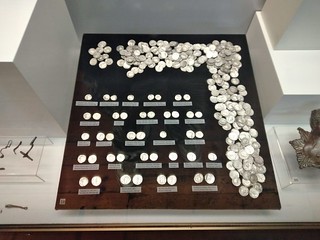 A coin hoard containing nearly 600 silver coins (denarii) from the 1st – 3rd century AD, most likely hidden during the first large-scale barbarian invasion of the Roman Empire, the invasion by the Goths in 250-251 AD, has been discovered by archaeologists alongside a partially preserved skeleton in a burned down building in ancient Philipopolis, today's Plovdiv in Southern Bulgaria.
A coin hoard containing nearly 600 silver coins (denarii) from the 1st – 3rd century AD, most likely hidden during the first large-scale barbarian invasion of the Roman Empire, the invasion by the Goths in 250-251 AD, has been discovered by archaeologists alongside a partially preserved skeleton in a burned down building in ancient Philipopolis, today's Plovdiv in Southern Bulgaria.
The impressive treasure, a collection of silver coins (denarii), includes coins minted by all Emperors, Empresses-consorts, and some other royalties of the Roman Empire from Antonius Pius (r. 138 – 161 AD) until Philip I the Arab (r. 244 – 249 AD) and Philip II.
The hoard of Roman denarii (silver coins) from the Invasion of the Roman Empire by the Goths in 250-251 AD when the Goths went as far south as Philipopolis (Plovdiv's predecessor) and ransacked it has been showcased as one of the most intriguing finds from last year in the 2020 Bulgarian Archaeology Exhibition. The exhibition was opened in February 2021 at the National Institute and Museum of Archaeology in Sofia.
"[The Roman silver coin hoard] tells an interesting story about the fate of today's Plovdiv and about a resident of the respective home who in a haste hid about 600 silver coins in a purse during an attack and burning of his home in the middle of 3rd century AD… The find in question can be connected with the historical data about the burning of the city by the Goths during that period," explains archaeologist Kamen Boyadzhiev, author of the official catalog of the 2020 Bulgarian Archaeology Exhibition, as cited by the Bulgarian National Radio.
To read the complete article, see:
LARGE SILVER COIN HOARD HIDDEN DURING 251 AD GOTH INVASION OF ROMAN EMPIRE DISCOVERED IN BULGARIA'S PLOVDIV
(http://archaeologyinbulgaria.com/2021/04/01/large-silver-coin-hoard-hidden-during-251-ad-goth-invasion-of-roman-empire-discovered-in-bulgarias-plovdiv/)
PIRATE YEMENI COINS IN COLONIAL AMERICA
Ross Johnson forwarded this Associated Press story about specimens of Arabian silver coins found by detectorists at Colonial Period sites in New England. -Editor
 A handful of coins unearthed from a pick-your-own-fruit orchard in rural Rhode Island and other random corners of New England may help solve one of the planet's oldest cold cases.
A handful of coins unearthed from a pick-your-own-fruit orchard in rural Rhode Island and other random corners of New England may help solve one of the planet's oldest cold cases.
The villain in this tale: a murderous English pirate who became the world's most-wanted criminal after plundering a ship carrying Muslim pilgrims home to India from Mecca, then eluded capture by posing as a slave trader.
"It's a new history of a nearly perfect crime," said Jim Bailey, an amateur historian and metal detectorist who found the first intact 17th-century Arabian coin in a meadow in Middletown.
That ancient pocket change — among the oldest ever found in North America — could explain how pirate Capt. Henry Every vanished into the wind.
On Sept. 7, 1695, the pirate ship Fancy, commanded by Every, ambushed and captured the Ganj-i-Sawai, a royal vessel owned by Indian emperor Aurangzeb, then one of the world's most powerful men. Aboard were not only the worshipers returning from their pilgrimage, but tens of millions of dollars' worth of gold and silver.
What followed was one of the most lucrative and heinous robberies of all time.
"If you Google ‘first worldwide manhunt,' it comes up as Every," Bailey said. "Everybody was looking for these guys."
Until now, historians only knew that Every eventually sailed to Ireland in 1696, where the trail went cold. But Bailey says the coins he and others have found are evidence the notorious pirate first made his way to the American colonies, where he and his crew used the plunder for day-to-day expenses while on the run.
The first complete coin surfaced in 2014 at Sweet Berry Farm in Middletown, a spot that had piqued Bailey's curiosity two years earlier after he found old colonial coins, an 18th-century shoe buckle and some musket balls.
Waving a metal detector over the soil, he got a signal, dug down and hit literal paydirt: a darkened, dime-sized silver coin he initially assumed was either Spanish or money minted by the Massachusetts Bay Colony.
Peering closer, the Arabic text on the coin got his pulse racing. "I thought, ‘Oh my God,'" he said.
Research confirmed the exotic coin was minted in 1693 in Yemen. That immediately raised questions, Bailey said, since there's no evidence that American colonists struggling to eke out a living in the New World traveled to anywhere in the Middle East to trade until decades later.
Since then, other detectorists have unearthed 15 additional Arabian coins from the same era — 10 in Massachusetts, three in Rhode Island and two in Connecticut. Another was found in North Carolina, where records show some of Every's men first came ashore.
Bailey, whose day job is analyzing security at the state's prison complex, has published his findings in a research journal of the American Numismatic Society, an organization devoted to the study of coins and medals.
To read the complete article, see:
Ancient coins may solve mystery of murderous 1600s pirate
(https://starexponent.com/news/national/ancient-coins-may-solve-mystery-of-murderous-1600s-pirate/article_855faa57-d06e-548f-a68d-ab73cb8f5b39.html)
The story spread far and wide this week. Thanks also to Mark Holton (of New Brunswick, Canada), Len Augsburger, Leon Saryan, B.J. Herbison, Howard Berlin, Dick Hanscom, Arthur Shippee and others who passed along other versions of the article. We've discussed these finds before - see the earlier E-Sylum articles linked below. -Editor
To read the complete articles, see:
Ancient coins may solve mystery of murderous 1600s pirate
(https://apnews.com/article/ancient-coins-may-solve-mystery-1600s-pirate-f5a6151b74e0dcf96de585eab451f90c)
Ancient coins found in Rhode Island may solve mystery of murderous 1600s pirate
(https://www.nbcnews.com/news/us-news/ancient-coins-found-rhode-island-may-solve-mystery-murderous-1600s-n1262823)
Ancient coins may solve mystery of murderous 1600s pirate
(https://abcnews.go.com/Entertainment/wireStory/ancient-coins-solve-mystery-murderous-1600s-pirate-76805122)
Dug up coins shed light on 1600s global pirate manhunt
(https://globalnews.ca/news/7735471/henry-every-pirate-coins/)
Ancient coins may solve mystery of murderous 1600s pirate
(https://www.newburyportnews.com/news/regional_news/ancient-coins-may-solve-mystery-of-murderous-1600s-pirate/article_f8f9ebe8-5082-57e7-ad1c-5404201ab831.html)
Ancient Arabian coins could solve mystery of the King of the Pirates
(https://www.jpost.com/archaeology/ancient-arabian-coins-could-solve-mystery-of-the-king-of-the-pirates-663885)
To read the earlier E-Sylum articles, see:
QUERY: YEMENI COINS IN COLONIAL AMERICA
(https://www.coinbooks.org/esylum_v19n33a15.html)
COLONIAL NEWSLETTER AUGUST 2017 ISSUE PUBLISHED
(https://www.coinbooks.org/v20/esylum_v20n44a03.html)
ARABIC COINS IN MEDFORD MASSACHUSETTS 1787
(https://www.coinbooks.org/v20/esylum_v20n45a29.html)
ARTICLE HIGHLIGHTS JAMES BAILEY'S COIN FINDS
(https://www.coinbooks.org/v22/esylum_v22n27a12.html)
1792 EAGLE-ON-GLOBE QUARTER PATTERN
This Heritage press release discusses the rare 1792 Eagle-on-Globe pattern. -Editor
One of just four known Eagle-on-Globe examples heads to auction April 22-26
One of four existing 1792 Judd-13 Eagle-on-Globe quarter dollar patterns, among the earliest pieces produced by the fledgling US Mint, appears fresh to market in Heritage Auctions' U.S. Coins Signature Auction, April 22-26 on HA.com.
"As one of the hobby's most coveted patterns, we're proud to bring this piece of numismatic and U.S. history to auction," said Greg Rohan, President of Heritage Auctions. "The inclusion of a white metal 1792 Eagle-on-Globe quarter in a sale is a landmark event."
The 1792 Judd-13 pattern, NGC AU58, is recognized as the work of Joseph Wright. Wright worked with the U.S. Mint to perfect the quarter dollar spanning various metal compositions, edge devices, reeding, planchet thickness, collar usage and die alignment. The result was a pattern coin composed of white metal.
Just two specimens were known to the hobby until 2002, when two additional white metal specimens were recognized in a museum display of Colonial coinage. The two coins were authenticated as Joseph Wright pieces, and the spectacular discovery doubled the known population from two to four.
An announcement of the discovery was made on May 17, 2003, as part of the American Numismatic Society's Coinage of the Americas Conference, and the coins were chronicled on the front page of Coin World on June 9, 2003.
The coins carry impeccable provenance, coming from the New-York Historical Society Museum & Library. The Museum will retain one of the two virtually identical specimens for research and display.
The 1792 Judd-13 pattern Eagle-on-Globe is well known within American numismatics. Several of the New York pattern coppers of 1787 employ the device, including the Excelsior, George Clinton and Standing Indian types (Breen 989, 990 and 991). The New York state coat of arms incorporated the Eagle-on-Globe in 1778. Later, the New York state flag and seal in turn included the coat of arms. The Erie Canal medal of 1826 (HK-1) depicts the New York coat of arms, including the Eagle-on-Globe design.
The present coin's silver-gray surface features a female bust on the obverse with the word LIBERTY above and clearly legible date below, while the reverse depicts an eagle with outstretched wings beneath the words "United States of America."
Bidding opens April 2. For more information on the 1792 Judd-13 pattern Eagle-on-Globe pattern and Heritage Auctions' April 22-26 U.S. Coins Signature Auction is available at HA.com/1329 .
Pete Smith comments:
"I have been fascinated with the Eagle-on-Globe patterns since 1986 when I examined a copper example at the Smithsonian. Now 229 years after they are dated, there are still more questions than answers about these pieces.
"The Heritage description states that the Judd-13 pattern, "is recognized as the work of Joseph Wright." This is recognized only because it has been stated by previous writers long after the fact. There is no contemporary proof that they were done by Wright, or even that they were struck in 1792, as they are dated.
"The artistic style is very different from the other 1792 patterns indicating that a different artist was responsible. They do not include the "Liberty Parent of Science and Industry" legend and do not bear a denomination. They are not the proper size for a quarter pattern. Another curious feature is that the reverse die is about 2 mm larger than the obverse die.
"Being one of four known examples would make the current piece an extreme rarity. However, there are differences within those four pieces. The two pieces held by the New- York Historical Society were struck in collar while the other two were struck out of collar. Thus the coin currently offered will be unique in private hands.
"I hope this coin will find a home with an appreciative collector rather than a dealer who hopes to make a profit on a later sale."
To read the complete lot description, see:
1792 Quarter Dollar, Judd-13, Pollock-15, High R.7 AU58 NGC....
(https://coins.ha.com/itm/patterns/1792-quarter-dollar-judd-13-pollock-15-high-r7-au58-ngc/a/1329-4960.s)
ORDNANCE VICTORY PENNIES
With permission, we're republishing this nice item on shell case cents by Bill Myers in the April 3, 2021 (Series 22 No. 2468) issue of MPC Gram, the newsletter for collectors of Military Payment Certificates and other military numismatica. Thanks! -Editor
Many years ago, Fred sent me a scan of his E-bay purchase. It was a folder from the Tooele Ordnance Depot with a US cent minted from 1944 to 1946 that was minted from brass reclaimed from shell casings (copper added to the 70% copper, 30% zinc shell casing to make 95% copper and 5% zinc). It was labeled as a "victory penny, it's been to war". Of course, my reaction was "I want one"! I found one on E-bay and bought it. Just last week I was searching E-bay last week and I came across a card with a 1944S cent composed of copper from the shell casing reclaimed at the Tooele Ordnance Department (should be Depot). It was a souvenir from the Utah Fair Association. I have not found much about the Utah Fair Association after World War II so I cannot determine the date this card was released but I assume it was close to the end of World War II.
As a bonus the cent on the card has a straight clip 0930 to 1200. The blank for the coin was punched out partly over the edge of the sheet of metal so part of the blank is missing. Of course, someone could have cut off part of the cent with shears to imitate the error coin. This coin exhibits the Blakesley effect which verifies it is a mint error. When a blank is put through the upsetting mill to create a proto-rim there must [be] resistance on the entire edge of the blank for it to form a rim. The defect on the blank prevents resistance on the opposite side so the proto-rim is not formed opposite the defect on the blank. When the coin is struck the area opposite the defect has a wider and flatter rim with some weakness of the design elements. This can be seen on the coin.
For me this was a great find for my World War II coin collection. I now have a World War II coin that is an error as well as a second item related to the Tooele Ordnance Depot.
To subscribe to the MPC Gram, see:
https://guide.us13.list-manage.com/subscribe?u=10eb366ab80344a56657e0d5d&id=58874b37e1
THE BOOK BAZARRE
BRITANNIA'S EVOLUTION
Louis Golino published an article on World Mint News Blog about the evolution of the Royal Mint's Britannia. Here's an excerpt - see the complete article online. -Editor
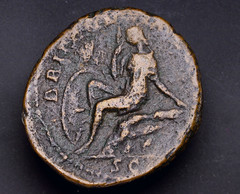 Long before Lady Liberty, Marianne, Germania, and other allegorical numismatic and cultural figures, there was Britannia — the oldest symbol of a nation personified as a strong female still used on coins today.
Long before Lady Liberty, Marianne, Germania, and other allegorical numismatic and cultural figures, there was Britannia — the oldest symbol of a nation personified as a strong female still used on coins today.
Her roots are in the Roman conquest of Britain and the use of deities that began in ancient Greece and Rome that first personified concepts like Liberty with a female goddess called Libertas in Rome and Eleutheria in Greece.
Roman Britannia
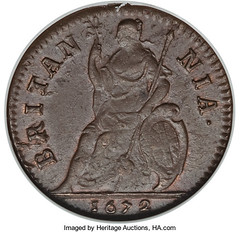 The Romans (for whom it was previously Albion, as Greek geographers called it) dubbed the British Isles Britannia (derived from the Latin "Britannicae") well before Julius Caesar's triumphant visit in 55 A.D. that was part of his effort to conquer Gaul. The first serious Roman attempts to invade the area were made by Claudius. After winning several battles, Claudius took the surname Britannicus, and several silver and gold coins honoring Claudius featured references to "E Britan" or "E Britannis".
The Romans (for whom it was previously Albion, as Greek geographers called it) dubbed the British Isles Britannia (derived from the Latin "Britannicae") well before Julius Caesar's triumphant visit in 55 A.D. that was part of his effort to conquer Gaul. The first serious Roman attempts to invade the area were made by Claudius. After winning several battles, Claudius took the surname Britannicus, and several silver and gold coins honoring Claudius featured references to "E Britan" or "E Britannis".
But it was later when Hadrian, who built his famous wall near the border between England and Scotland, that Roman influence increased in the area, which included the building of a shrine in York to Britannia depicted as a goddess. It was during this period (around 119 A.D.) that the first Roman coins were struck that featured a female figure who represented the personification of Britain and mentioned Britannia.
And this Britannia of Roman coinage was based on the Roman goddess of wisdom, Minerva — a warrior-goddess who guided soldiers in battle and sported a helmet, spear, and shield, as has Britannia, for more than 2,000 years.
Britannia Revived
Many of those motifs used to depict Britannia on Roman coins would later be used when the figure reappeared on British coins of the realm after disappearing for over 1,000 years when Rome fell in 395 A.D., starting in 1672 during the reign of Charles II. The idea may have been revived to inspire the British at a time when the country's naval power was under threat by Spain.
On copper half pennies and farthings, Britannia was shown seated on a rock with an olive branch in her right hand and a spear in her left hand with a shield bearing the Union flag leaning against the rock.
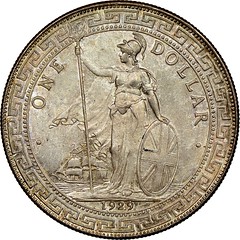 In the centuries since then, Britannia has continued to appear without interruption on the coinage of the British monarchy and the United Kingdom, appearing to this day on circulating 50-pence and £2 coins.
In the centuries since then, Britannia has continued to appear without interruption on the coinage of the British monarchy and the United Kingdom, appearing to this day on circulating 50-pence and £2 coins.
The many different versions of her image over the centuries were clearly designed to convey that message that she is the stoic protector of the British nation and of the territorial integrity and security of Britain, but she also represents the British nation and people themselves and their history.
To read the complete article, see:
Britannia's evolution from Ancient Rome to Modern Britain
(https://world.mintnewsblog.com/2021/04/britannias-evolution-from-ancient-rome-to-modern-britain/)
GERMAN GEORGE II MEDAL OFFERED
Dix Noonan Webb is offering a German gold medal with the earliest known portrait of George II. Here's the press release. -Editor
A gold medal showing the earliest known portrait of Georg August, Electoral Prince of Brunswick-Calenburg-Hanover, who would later become King George II, is to be offered in a sale of Coins and Historical Medals on Tuesday & Wednesday, April 6 & 7, 2021 at International coins, medals, banknotes and jewellery specialists Dix Noonan Webb.
Dating from 1701, the year of his 18th birthday, the medal shows the Prince, who was the last British monarch born outside England, on one side and Schloss Herrenhausen, Hanover on the other. It is estimated at £6,000-8,000.
Peter Preston-Morley, Head of the Coin Department and Associate Director, Dix Noonan Webb, explained: "This is a very rare depiction, thought to be the earliest portrait of George II - at this time he had no idea that he would be king! It is from an old Irish collection, the formation of which is shrouded in mystery, but it is likely to date from the early 19th century, if not earlier."
The sale will also include the fourth and final part of the Walter Wilkinson Collection of Coins of Elizabeth I (1558-1603). Comprising 358 lots, of note is a very fine and very rare seventh issue Crown, which was previously in the Eleanor Ahbe Collection and is estimated at £7,000-9,000, while very clear example of a seventh issue Crown, that was once in the Lord Rodney Smith Collection carries an estimate of £5,000-7,000.
Also in the sale is the Ross King Collection of British Coins. As Mr King, who has been collecting for 67 years and lives in Canada, explains: "While putting this collection together I was drawn to George III in particular, with all the major historic events during the period of his long reign. Just think of all that happened during these years – the American Revolution, the French Revolution, the Napoleonic wars, the War of 1812 but most importantly, as far as coinage was concerned, the Industrial Revolution which completely changed the way coins were minted (the Cartwheel twopence showed the power of the new steam presses). The unusual types of coins struck under George III (Bank of England ninepence and one shilling and sixpence, countermarked Spanish 8 réales, etc), the proofs, patterns, medals and plethora of 18th and 19th century merchant tokens all drew me in and held me for many years."
Interesting items among the 67 lots include from the reign of George III (1760-1820) a very fine and very rare Pre-1816 issues Guinea, dating from 1761, which carries an estimate of £3,000-4,000, while a George III Pre-1816 issues, ‘Military' Guinea, dating from 1813, is expected to fetch £3,000-3,600.
For more information, see:
https://www.dnw.co.uk/
SIEGE OF PEKING BOXER REBELLION MEDAL
Stack's Bowers Senior Numismatist and Cataloger Jeremy Bostwick wrote an article about a great medal in their upcoming Hong Kong sale. -Editor
As recounted in one of our previous blog posts, the tensions between westerners and their Chinese hosts reached an untenable level by the summer of 1900, with the Empress Dowager Cixi (the real power behind the Qing dynasty) siding with the "boxers" in what would become known as the Boxer Rebellion. Tired of what they viewed as meddlesome invaders from the west, the alliance between imperial forces and the band of boxers declared war and eventually laid siege to the Legation Quarter in Beijing (Peking), where numerous foreign nationals from many western powers were stationed. After nearly two months, the siege was broken by an eight-nation alliance, with the Qing dynasty being greatly weakened in the aftermath. While many coins date to this period, even more historical appeal is offered by a rare and exceedingly attractive medal in our April Hong Kong auction.
Struck at the request of Arthur D. Brent, an employee of the Hong Kong & Shanghai Bank, the "Siege of Peking" medal was given to others present during the aforementioned siege, the group comprising Europeans, Japanese, and Christian Chinese taking refuge in the Legation Quarter. One such member was the recipient of the medal in question—Basil Kroupensky (??????? ?????????? ??????????), a Russian diplomat in the middle of his stint as 1st Secretary of the Russian delegation in Peking. He would also serve in similar positions as the Russian ambassador to the United States, the Republic of China, and Japan.
The medal features great intricacy in its iconography and design elements, with the obverse legend referring to an inscription illuminated in Balshazzar's Feast, a painting by Rembrandt. On the wall depicted in the painting, the Hebrew phrase that is transliterated on the medal became an English expression used for foreshadowing doom – "the writing is on the wall" – the idea that one's fate has been sealed. In the context of the medal, the glory and good times enjoyed by Europeans within the legation had seemingly come to an ominous end at the hands of the Chinese beyond their walls. Within the obverse legend, one sees female allegories of Germany and Great Britain standing facing one another and clasping hands along with allegory of Japan in background; at their feet, they tread upon a coiled dragon emblematic of the Qing Empire and the Boxers laying siege from outside. The reverse displays the dates of the siege and a frontal view of the Qianmen (Zhengyangmen) Gate, under siege and engulfed in a plume of smoke slightly zoomorphized as a snarling dragon. The end result is an engaging and important piece of artistry that masterfully captures the chaos that raged during this very pivotal period in modern Chinese history.
To view our auction schedule and future offerings, please visit StacksBowers.com where you may register and participate in this and other forthcoming sales.
To read the complete lot description, see:
CHINA. China - Germany - Great Britain - Japan - Russia. Siege of Peking Bronze Award Medal, 1900.
(https://auctions.stacksbowers.com/lots/view/3-QDBHV/china-china-germany-great-britain-japan-russia-siege-of-peking-bronze-award-medal-1900-pcgs-specimen-65-gold-shield)
To read the complete article, see:
The Web of Conflict: A Rare Medal Pertaining to the Boxer Rebellion
(https://www.stacksbowers.com/News/Pages/Blogs.aspx?ArticleID=medal-boxer-rebellion-world-coin-auction)
GEORGE FLOYD'S COUNTERFEIT $20 BILL
The New York Times and other news outlets reported this week from the trial of the police officer who killed George Floyd earlier this year, touching off riots nationwide. The incident all began with a $20 bill believed to be counterfeit. -Editor
He chatted with a store clerk about playing football. He grabbed a banana off a shelf, flipped through a wad of cash, and hugged and exchanged pleasantries with a woman, laughing with his hand on her back.
In surveillance footage played for the first time in a Minneapolis courtroom on Wednesday, the world got to see George Floyd as it never had before: He was just another customer in a corner store that he liked to frequent.
Within half an hour, Mr. Floyd would be handcuffed and face down on the pavement outside of Cup Foods, calling out for his mother as a police officer pressed his knee into Mr. Floyd's neck. Roughly two hours after he walked into the store he was dead.
The 19-year-old clerk who served Mr. Floyd at the corner store that day wondered whether the death was his fault because he had reported that Mr. Floyd used a fake $20 bill.
At the counter, Mr. Floyd can be seen offering the teenage clerk, Christopher Martin, a $20 bill in exchange for a pack of cigarettes. Mr. Martin said he quickly realized the bill was counterfeit; the blue pigmentation gave it away, he testified. For one brief moment, Mr. Martin thought to let it go and put it on his own tab — the store's policy was that fake money would be deducted from the paycheck of the employee who accepted it, he said. But then he changed his mind.
He told his manager, who sent him after Mr. Floyd. But after Mr. Floyd refused to come back in, another employee called the police.
I'm still curious to know what became of that note - is it in an evidence locker somewhere? Was it actually counterfeit? -Editor
To read the complete article, see:
Clerk Who Questioned $20 Bill Watched Floyd Arrest With ‘Disbelief and Guilt'
(https://www.nytimes.com/2021/03/31/us/chauvin-trial-floyd.html)
PROTESTERS SPRAY DYE ON BANK OF ENGLAND
Protesters defaced the facade of the Bank of England this week. -Editor
Climate activists in London splashed black dye on the facade of the Bank of England's imposing neo-classical headquarters on Thursday as part of a protest against the finance sector's support of what they say is a climate catastrophe.
Activists, some dressed as jesters, sprayed the dye at the building, known as "the Old Lady of Threadneedle Street", leaving black stains on the main entrance to the building.
"This bank is killing us," read a banner held up by one protester. "No more fossil fuels," read another.
In London, police said they had arrested four people, one for trespassing and three for criminal damage.
The Bank of England declined to comment when asked by Reuters for a response to the action.
"The action today is part of a wave of actions by XR's Money Rebellion designed to expose the role of banks in the climate and ecological crisis," the environmental movement Extinction Rebellion said. The action is being cast by the group as a "Money Rebellion."
The Bank of England was established in 1694. John Soane's majestic Bank of England building was finished in the early 19th century but only the exterior of that remains. The rest was demolished and rebuilt in the early 20th century.
To read the complete article, see:
Climate activists spray black dye at Bank of England in 'Money Rebellion'
(https://www.reuters.com/article/uk-britain-climate-protests-idUSKBN2BO52Z)
LOOSE CHANGE: APRIL 4, 2021
Here are some additional items in the media this week that may be of interest. -Editor
Aaron Oppenheim passed along this article following up on the Georgia man who was dealing with a 500-pound pile of oily pennies from his former employer. -Editor
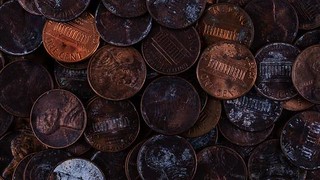 Coinstar took up the mantle and picked up the more than 500 pounds of pennies from Flaten on Thursday.
Coinstar took up the mantle and picked up the more than 500 pounds of pennies from Flaten on Thursday.
The company pointed Fox News to a release in which it wrote that it also rounded up Flaten's paycheck to $1,000.
"When we heard about Mr. Flaten's penny problem, we were happy to offer our assistance," said Coinstar CEO Jim Gaherity. "Coinstar has been in the coin business for 30 years and we process approximately 41 billion coins annually – so picking up 91,000 pennies was all in a day's work."
"I was spending an hour or two a night trying to clean the pennies and probably only cleaned off about $5 worth," Flaten told Coinstar. "I was so relieved and grateful that Coinstar agreed to help me."
In addition, company executives announced that they would match Flaten's penny value and donate $1,000 to local charities of his choosing.
Flaten named two Atlanta-area animal shelters to receive the donations.
To read the complete article, see:
Coinstar fixes Georgia man's oily penny paycheck problem
(https://www.foxnews.com/us/coinstar-fixes-georgia-mans-oily-penny-paycheck-problem)
To read the earlier E-Sylum article, see:
THE 500-POUND POMADED PENNY PILE
(https://www.coinbooks.org/v24/esylum_v24n13a35.html)
The British spy agency GCHQ is offering The Turing Challenge. Can you solve the banknote puzzles? -Editor
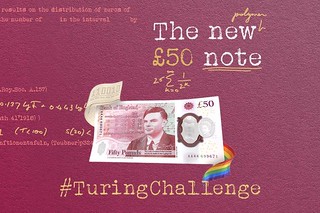 To celebrate Alan Turing featuring on the new £50 banknote, we've created our hardest puzzle ever in his honour.
To celebrate Alan Turing featuring on the new £50 banknote, we've created our hardest puzzle ever in his honour.
The #TuringChallenge requires you to solve a string of puzzles which get increasingly difficult. Crack the answers to the first 11 puzzles which should give you 11 single words or names which you'll need your very own Enigma simulator to decode!
Keep an eye on our Twitter and Instagram channels throughout the day for tips and hints.
To read the complete article, see:
The Turing Challenge
(https://www.gchq.gov.uk/information/turing-challenge)
RIVERBOAT DISASTER THREATENED CHEROKEE PAYMENT
When recovered from the ocean floor in 2014, the purser's safe of the S.S. Central America contained a combined total of $1,588.95 face value of U.S. coins from silver dimes to Half Eagle $5 gold coins. From the Oklahoma Muskogee Phoenix comes this story of another steamship and its lost (and found) money. -Editor
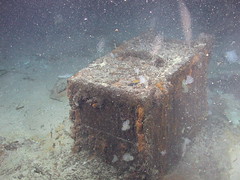 An early steamboat was named the Cherokee, which plied the rivers between New Orleans and Fort Gibson on the Grand River and the Creek Agency on the Verdigris River. In December of 1840, the Cherokee carried as a passenger Captain William Armstrong, the superintendent of Indian Affairs for the western tribes. Armstrong had traveled to New Orleans to secure a payment for the Cherokees in accordance with their treaty with the federal government. The payment of over $100,000 was to be made at Fort Gibson.
An early steamboat was named the Cherokee, which plied the rivers between New Orleans and Fort Gibson on the Grand River and the Creek Agency on the Verdigris River. In December of 1840, the Cherokee carried as a passenger Captain William Armstrong, the superintendent of Indian Affairs for the western tribes. Armstrong had traveled to New Orleans to secure a payment for the Cherokees in accordance with their treaty with the federal government. The payment of over $100,000 was to be made at Fort Gibson.
The paper money making up the bulk of the payment was sealed in watertight kegs. An additional amount in gold and silver coins was locked in two strongboxes and kept in the clerk's office.
After the steamboat had passed Little Rock and was 60 miles upriver of that town, the Cherokee's boiler exploded. Tragically, some 15 crew and passengers were killed and several others were wounded. The boat was badly damaged by the explosion and within an hour sank in the Arkansas River.
Capt. Armstrong reported to his superiors that the box of gold was blown onto shore, split open and the coins spilled out. Armstrong estimated about $90 worth of coins were lost. The box of silver coin, dimes and "half-dimes," was blown onto the bow of the boat and virtually disintegrated. Armstrong scrambled to retrieve all the change he could and estimated he saved all but about $50.
The kegs holding the paper money fell to a lower deck of the boat, but because they had been secured with iron hoops they did not break apart. None of the paper money was lost. Armstrong, however, was forced to wait several days at the site of the explosion, guarding the money. It was a great relief to him when another steamboat arrived to carry the retrieved funds on to Fort Gibson where they were distributed to the Cherokees gathered there.
To read the complete article, see:
Three Forks History: Riverboat disaster threatened Cherokee payment
(https://www.muskogeephoenix.com/news/lifestyles/three-forks-history-riverboat-disaster-threatened-cherokee-payment/article_5f8d9c0d-7ac4-5166-a4f3-3221f4464fb6.html)
To read the earlier E-Sylum article, see:
SS CENTRAL AMERICA CASH BOX FINDS
(https://www.coinbooks.org/v22/esylum_v22n07a15.html)


